INDUSTRIAL & OFFLINE
TERMINAL RAILROADS &
RAIL-MARINE OPERATIONS
OF BROOKLYN, QUEENS, STATEN
ISLAND, BRONX &
MANHATTAN:
| JAY STREET
TERMINAL, JAY STREET EXTENSION RAILROAD & JAY STREET CONNECTING RAILROAD Vinegar Hill, Brooklyn, NY |
 |

.
|
updated: |
||
|
|
||
|
update summary: |
date: | chapter: |
| undated photos of #1 and #2 added | 11 January 2023 | Locomotive Photos |
| 1930 photo of #1 added | 11 November 2022 | Locomotive Photos |
| 1907 Freight Tracer postcard added | 10 November 2022 | Memorabilia |
| 9/27/1951 photo of #300 added | 30 October 2022 | Locomotive Photos |
.
.
.

| Jay Street Terminal History & Property | Businesses | ||
| Locomotive Overview | Locomotive Photos | ||
| Memorabilia | Memoirs |
.
.
.
Overview
.
.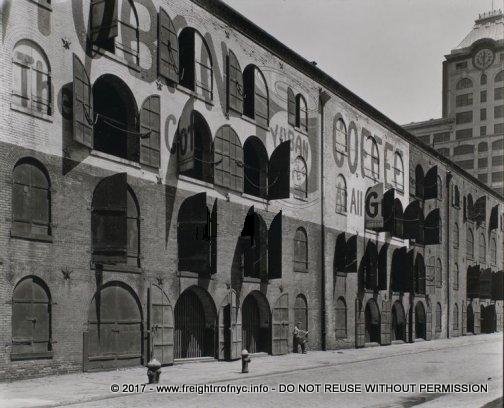
Arbuckle Brothers Coffee Storage Warehouses,
Water Street, Brooklyn - 1935
.
The Jay Street Terminal / Connecting
Railroad was located on both sides of as well as ran under
the
Manhattan Bridge and its immediate vicinity of what is now known as
"DUMBO" or Down Under Manhattan Bridge Overpass. But the historic name
for the neighborhood was Vinegar Hill.
The Jay Street Connecting was the last of the Offline Rail-Marine Terminals to be organized in Brooklyn, taking place on October 9, 1909; that being with Palmer's Dock having been organized in 1876, New York Dock in 1901 and Bush Terminal in 1905. Their is some question regarding this 1909 date, as the Public Service Commission lists 1909 as the organization date, but mentioned in a New York Times article dated 1911, stated the Jay Street Terminal was organized "six years ago" which woud put the date at 1905, but no other documents can be located to confirm this date.
The Jay Street Connecting was also the smallest of the Offline Rail-Marine Terminals in Brooklyn, and it would be the first to cease operations in 1959.
However, the Jay Street Connecting is also renowned for having the most eclectic collection in terms of equipment, both locomotives and marine craft!
The Jay Street Connecting Railroad was incorporated October 9, 1909; organized April 28, 1910, and filed with the city of New York for a contract to operate in or across public streets in June 29, 1911. Their first tariff schedule for transporting freight took effect on September 19, 1911.
|
. The Arbuckle Brothers History in New York The history of the Arbuckle Brothers predates their relocation to New York, but for reasons of clarity I have only concentrated on their history after their arrival in New York. The Arbuckle Brothers: John & Charles [d. 1890]; first organized their company in New York City in 1871. Their primary commodity was coffee, being imported by the Arbuckle Brothers for their name brand: "Ariosa". This brand of coffee would become famous worldwide, and very desired among the cowboys in the Western US. The Arbuckle Brothers ran into some tribulations when Henry Havemeyer (of Palmers Dock / East River Terminal / Brooklyn Eastern District Terminal as well as Havemeyer & Elder Sugar Refining history) began raising prices of refined sugar being purchased by the Arbuckle's. One thing led to another including some bad blood, so the Arbuckle's built their own sugar refinery in 1897. To build the refinery, they hired Joseph Stillman (a former employee of the Havemeyer's) who at that time was the leading expert in sugar refining. The refinery opened in 1899, much to the chagrin of Henry Havemeyer. To exact revenge, Havemeyer entered the coffee business and for quite some time, there would be a price war on coffee with both parties lowering prices to outsell the other brand. Each party spent about 12,500,000 dollars fighting the other in legal fees and other incidentals. Eventually both Arbuckle and Havemeyer would wind up selling their coffee for less than cost. In 1901, Arbuckle and Havemeyer had a "sit down" and ended their feud and sugar and coffee prices went back up. With that "competition" problem solved, Arbuckle entered the tugboat monopoly on the Hudson River. |
 |
The impetus for Arbuckle entering the tugboat / towing field was that he thought that the going rate of $50 for a barge to be towed from New York City to Albany was too steep, so Arbuckle entered the market. Within a short time the towing charges dropped to $5!
In 1905, the Arbuckle firm introduced a new coffee brand named "Yuban".
Obviously from referencing various government documents and locomotive builders records, the railroad was operating several years by this time. A second railroad known as the Jay Street Extension Railroad Corporation was incorporated on January 8, 1916. Very shortly after that, the original Jay Street Connecting Railroad was consolidated with this newer Jay Street Extension Railroad, with the new entity being called Jay Street Connecting Railroad and being incorporated on April 3, 1916. Both of these railroads would be owned by the parent corporation "The Jay Street Terminal".
It is presumed by reading the details in the Public Service Commission Abstract Report of 1917 at below right that all this consolidation and reincorporation was due to the original contract needing to be voided because the railroad failed to construct certain trackage and rerouting other trackage in an agreement with the City of New York.
The Jay Street Terminal and likewise the railroad(s) was owned by John Arbuckle (b. July 11, 1839 in Alleghany City, PA - d. March 27, 1912) and William A. Jamison.
.
.
Jay Street Terminal History
& Property
The Jay Street Connecting Railroad / Jay Street Terminal, for all intents did not have vast property holdings, as did Brooklyn Eastern District Terminal, New York Dock or Bush Terminal; and the Jay Street Terminal did not have a great many buildings to call their own (keeping in mind that Arbuckles Coffee Warehouses were a separate entity).
Joe Roborecky submitted the following information located in Google Book Search which was contained in the Federal Reporter, Volume 200, Circuit Courts of Appeals, District Courts and Commerce Court of the United States, January - February 1913:
"...within the said lighterage limits is the Jay Street terminal. This terminal is located at the foot of Bridge street, Brooklyn, on the East River, having a water frontage of 1,200 feet and a depth of 600 feet. Its equipment consists of a large freighthouse, two Baldwin locomotives, three tugboats, two steam lighters, eleven barges, nine carfloats. The capacity of the yard is about 235 cars. The Jay Street terminal is a union freight terminal for all said petitioners, and is designated as a regular public freight terminal of petitioners in their tariffs filed with the Interstate Commerce Commission. It is owed by a copartnership composed of William A. Jamison and John Arbuckle, conducting such freight terminal as a separate business under the name and style of "Jay Street Terminal," under certificate filed with the clerk of New York county in accordance with the law of the state of New York, and is operated as a freight station for petitioners under and pursuant to several contracts between petitioners and the Jay Street Terminal, which contracts are substantially identical in their terms and provisions.
The initial property holdings consisted of land between Adams Street through Hudson Avenue west of John Street and would consist of three piers, a float bridge, enginehouse and team yard.
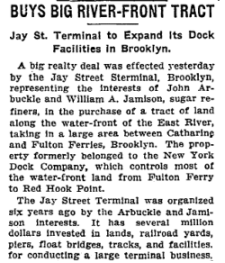 |
In 1911, the Jay Street
Terminal acquired additional property between Catherine
Ferry landing (now Main Street) and the Fulton Ferry landing (now
Cadman Plaza West) via purchase from the New York Dock Co.
It was proposed at that time, that the Jay Street Terminal would expand and put in additional float bridges, new piers, etc. You can read the pertinent details of this acquisition in the October 14, 1911 article from The New York Times at left and right. Most importantly, this acquisition procured for them several warehouses, giving them some storage capability, however limited. |
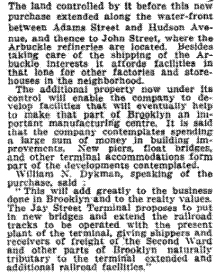 |
Joe Roborecky also came across the following multi-page article in the Bulletin of the Merchants Association of New York "Greater New York" dated April 6, 1914, where it states the various terminals located in Brooklyn on that date:
Greater New York - Bulletin of the Merchants Association of New York - April 6, 1914
.
.
The following is a summary and pier dimensions as listed in "Ports of the United States, 1916", and gives us a better understanding of the new dimensions of the Jay Street Terminal properties:
"The Jay Street Terminal is the fourth of the private terminals on the Brooklyn water front. This terminal is operated by a partnership whose members are identified with the Arbuckle Brothers. sugar refinery and coffee mills. This terminal, which was opened to the public in 1905, is located on the East River just north of the Brooklyn Bridge and occupies an area of about 200,000 square feet.
The property of the Jay Street Terminal includes six piers. Three of the piers, with a ground area of 66,788 square feet and a shedded area 60,648 square feet, as well as several warehouses, with a total floor area of 440,800 square feet, were acquired from the New York Dock in 1911. Two of the piers are open, while one has a shed with an area of about 7,000 square feet.
The Jay Street Terminal is equipped with locomotives, lighters, and other equipment for the interchange of freight with the trunkline railroads. It has a yard capacity of 250 cars and it's equipment includes a gantry crane of 20 tons capacity for handling heavy machinery and other bulk freight."
.
| pier | location | dimensions | occupant |
|
3 |
Brooklyn Bridge | 191' x 105' | |
| 2 |
to |
355' x 55' | |
| 1 |
Main Street |
408 ' x 35' | |
| Adams Street | 289' x 30' | ||
| Jay Street | unknown | ||
| Jay Street | unknown |
Ports of the United States, 1916
Department of Commerce - Bureau of Foreign & Domestic Commerce
Miscellaneous Series - No. 33
Report on Terminal Facilities, Commerce, Port Charges,
and Administration as Sixty-Eight Selected Ports
by Grosvenor M. Jones
.
.
After John Arbuckle passed away in 1912, his nephew William
A. Jamison took control of the Arbuckle Brothers properties, including the
Jay Street Terminal. The Arbuckle Brothers Company
would expand into several fields including groceries and sundries, as well
as the shipping and receiving of commodities through the Terminal.
In 1917, the Arbuckle Brothers would build an eleven story coffee and sugar warehouse at Jay, Main & Plymouth Streets. This building was constructed with nine railroad sidings inside on the ground floor (similar in function to the Austin Nichols building, as constructed by Havemeyer & Elder at the Brooklyn Eastern District Terminal).
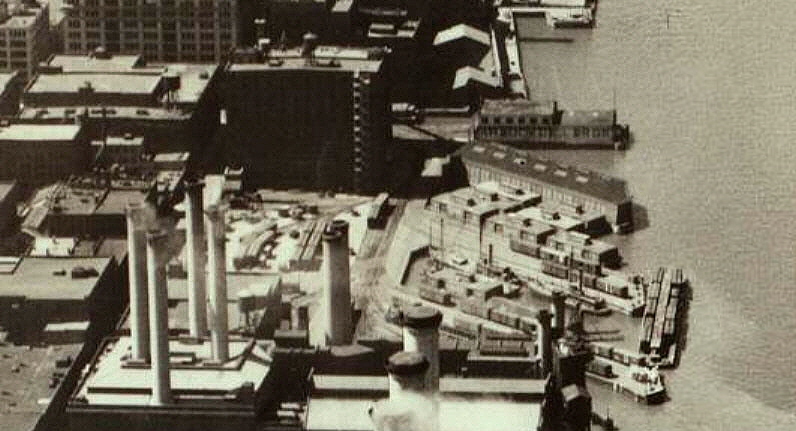
Fairchild Aerial Survey Photo - Jay Street Terminal
- 1924
New York Public Library Digital
Archives
added 09 December 2008
.
.
In the 1924 Fairchild Aerial Survey Photo above, located and submitted by Joe Roborecky; we can see several interesting details of the yard facilities of the Jay Street Connecting Railroad / Jay Street Terminal. Please keep in mind that in this photo, north is right and east is down.
Starting towards the top of the photo and along the bulkhead, we can see one of the freighthouses on the pier (perpendicular to the bulkhead) marked for "Arbuckle Brothers".
Between the southernmost diagonal piershed / pier and the pier yard, we see seven covered barges moored in the slip. All appear to have their doors closed, and all appear to have cupolas on the roofs. These cupolas are most unique as most railroad covered barges had flat roofs.
In the next slip east (down) we see two steamers. These two steamers are believed to be the Jay Street steam lighters "John Wise" and the "Santos". Another covered barge, this one with its doors open, is moored to the pier below the steamers, and between the steamers and the covered barge, appears to be a short three track interchange carfloat. Blocking this slip at the end of the pier is a loaded station carfloat.
The next pier north contains another railyard which is partially obscured by the smokestacks. To the right of the topmost large smokestack (which appears to be capped, as well as its northern sibling!) we can make out one side of the float bridge which appears to be a pony plate girder.
In the railyard east of the piers, we can see two trucks next to the group of five boxcars on the left and between those five boxcars and the six boxcars on the right.
What are not seen, is any discernible locomotives.
The following table and information, was compiled by Michael Smith of the Rail-Marine Information Group for Tom Flagg's article in Transfer Issue #44 (January - December 2006). It reports the the annual freight cars handled and persons employed at the Jay Street Terminal for the years listed.
| year | ... | cars | ... | employees |
| 1943 | 26,983 | 149 | ||
| 1944 | 27,923 | 159 | ||
| 1945 | 24,545 | 159 | ||
| 1946 | 23,218 | 159 | ||
| 1947 | 20,852 | 148 | ||
| 1948 | 17,050 | 94 | ||
| 1949 | 11,958 | 81 | ||
| 1950 | 13,493 | 86 | ||
| 1951 | 15,236 | 93 | ||
| 1952 | 14,493 | 92 | ||
| 1953 | 14,363 | 85 | ||
| 1956 | 18,445 | 26 | ||
| 1959 | 1,540 | 47 |
The Jay Street Terminal, on average, handled thirty three to seventy five freight cars per day over the above listed time period. The Wyer Report of 1944 states that the Jay Street Terminal handled 430,701 tons of freight in 1942, or about 1,180 tons per day. That translates to an average of 29½ forty ton boxcars handled per day (using a standard 40 foot steel boxcar common to that period). But keep in mind open gondolas containing oversize freight and hoppers of coal was also handled by the Jay Street Terminal as well.
Approximately 10% of this traffic was Less Than Carload Lot (LCL) freight, which confirms prior information that the Jay Street Terminal operation was primarily full carload consignments for the industries served by the railroad.
Unfortunately on August 5, 1958, with mounting debt and dwindling income, the Jay Street Connecting Railroad was notified by the trunk line railroads that no more credit would be extended to it. On or about the same day, the Jay Street Connecting Railroad tugboat (John A. McCormick?) met with an accident and ruled unfit by the Coast Guard, and thereby would necessitate the rental of another tug, if operations were to continue.
According to documents, the railroad was operating at a loss for the previous five years, and due to the lack of operating funds (apparently the the Jay Street Terminal had only $400 in liquid assets at this time), it could not repair the McCormick or even rent another tug. Therefore, to prevent an accumulation of freight cars; a decision was made to embargo all freight, incoming and outgoing.
On August 6, the customers were notified of this embargo which would become effective at midnight, August 8, 1958. At this same time, the railroad notified its employees that their service would not be needed after that date as well. The customers of Jay Street Connecting Railroad took this embargo to mean an actual abandonment (which was in fact what it really was), and therefore filed the injunction. The railroad naturally filed an appeal, citing its cash poor state, and of which it won that appeal.
|
As inferred however by the abandonment papers of 1958, the Jay Street Connecting Railroad / Jay Street Terminal instead of storing freight in warehouses or depots, delivered the cargo straight from carfloat to customer. Therefore, according to this document there was no longer a "public" terminal located at Jay Street Connecting Railroad / Jay Street Terminal and freight was handled by the full carload only. You can view and read these filings in the above Overview chapter. So all things being said, the Jay Street Connecting Railroad / Jay Street Terminal had a small freight yard off its single float bridge for assembling strings of cars for outbound car floating, but for the most part in the later years; incoming cars were brought directly to the customers structure located on spurs and sidings. This limited method of delivery, and no longer having the capacity for LCL (Less than Car Load) storage, was apparently one of the factors stacked against the survival of the Jay Street Connecting Railroad / Jay Street Terminal. In addition to that, there was no room for the Jay Street Terminal to expand along the waterfront for it to even compete with the other independent rail-marine contract terminals located in Brooklyn: Brooklyn Eastern District Terminal, New York Dock or Bush Terminal. Matter of fact, in one of several appeals filed on behalf of the owners of the Jay Street Terminal, it was revealed that the Jay Street Terminal yard property had already been sold to Consolidated Edison (a utility company) for $1,300,000. The contract for this sale was dated July 29, 1958, seven days before the the owners announced their intention to embargo. Furthermore, the closing of title was contingent upon removal of the float bridge. The actual end of the Jay Street Connecting did not come as swiftly as its owners would have liked however. Between appeals, protests and legal actions; it would be almost a full year before the Jay Street operation could close its doors.
As evidence by the New York Times article to the right, even
New York Dock Railway got into the fracas by offering to continue rail service
to the soon to be former Jay Street customers, but only if a connecting track
could be built at no cost to New York Dock. You can read the full injunction and appeal here: Jay Street Terminal Abandonment Filing; 1958 - 1959 The Jay Street Connecting Railroad and the Jay Street Terminal would continue to operate until June 27, 1959; when it finally ceased operations by the owners. It would be the first of the independent "contract" terminals in Brooklyn to close its doors. It would not be the last... |
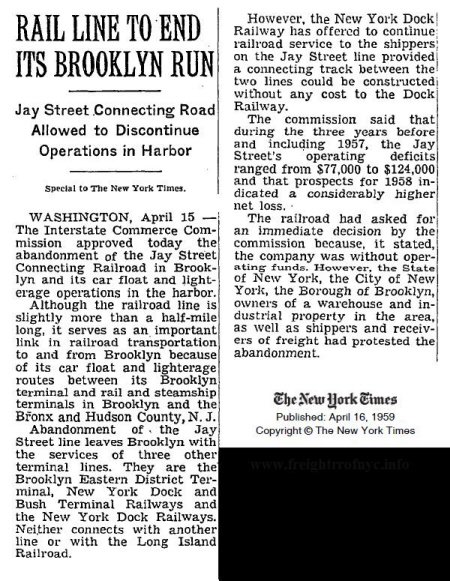 |
.
Other than the obvious service the Jay Street Connecting provided to the Arbuckle Sugar & Coffee refining establishments & businesses, other firms that utilized rail sidings connected to the railroad were as follows.
| firm | commodity | location | dates of service |
| Kirkman & Sons.. | soap | Plymouth & Bridge Streets.. | < 1916 - 1944 > |
| Masury & Co. | paint works.. | Plymouth Street | < 1916 > |
| E. W. Bliss | munitions | Plymouth & Adams Streets | < 1914 > |
| Robert Gair | cardboard & packaging | Plymouth, Main, Water Streets | 1912 - 1919 |
| Brillo | steel wool | Plymouth Street | < 1944 > |
| Pittsburgh Plate Glass | glass | Plymouth Street | < 1944 > |
| Newark Paper | paper | Plymouth & Adams Streets | < 1944 > |
| Empire Stores | storage & warehousing | Plymouth Street | < 1911 - 1950s |
| Phoenix Paper | paper | John & Bridge Streets | < 1912 > |
| Frost Brothers | coal | John Street between Bridge & Jay Streets | < 1912 > |
| Atlantic & Pacific Tea Co | grocers | ||
| Quaker Maid | |||
| Planters | nuts & chocolates | ||
| Sperry Gyroscope | navigation equipment & searchlights |
In January 2021, I was fortunate to acquire a Tariff Sheet dated October 26, 1953 and in effect on November 26, 1953. It reveals not only a complete list of customers on that date but also the limitation of shipping and receiving, switching, weight & clearance restrictions, facilities and crane capacities, floatage limits among other interesting tidbits:
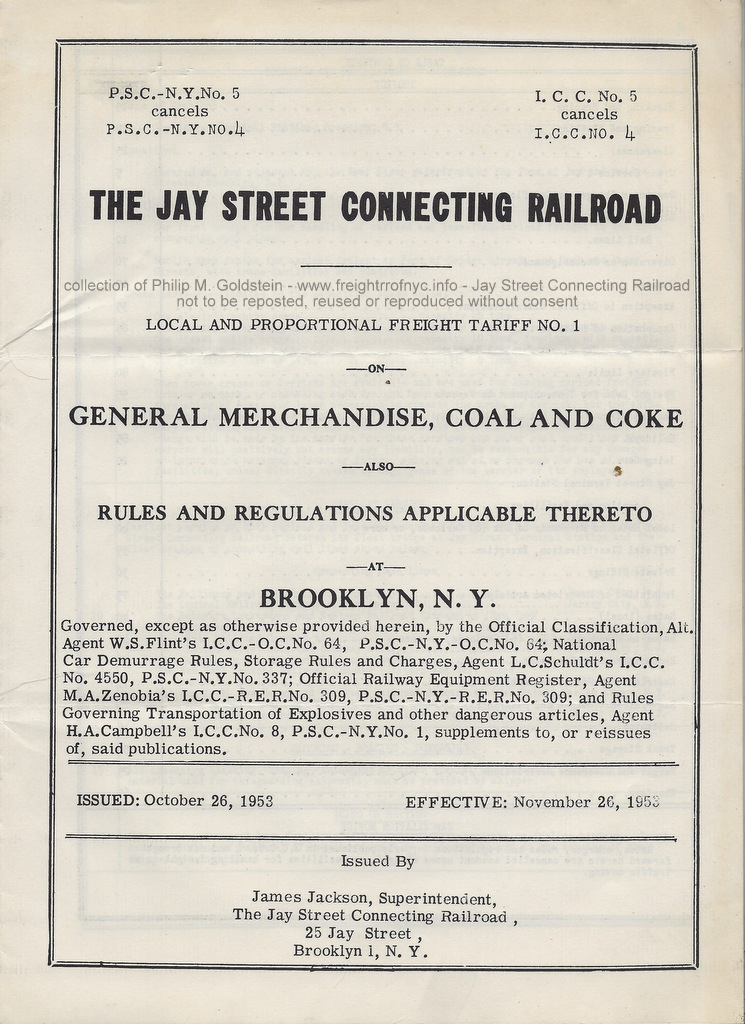 |
 |
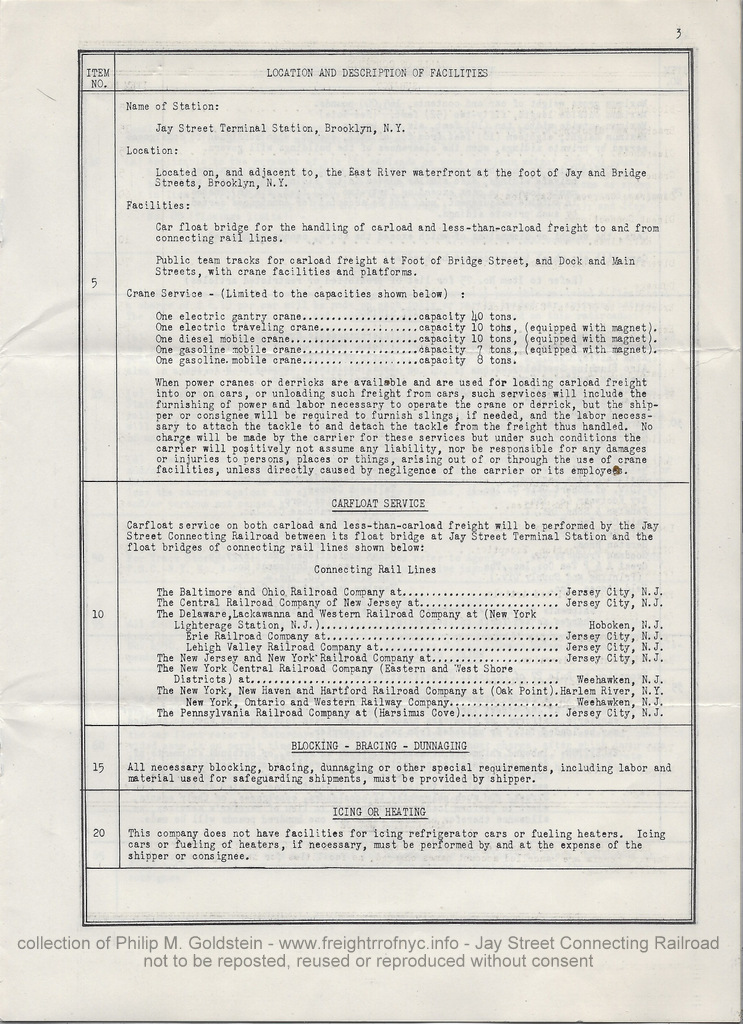 |
 |
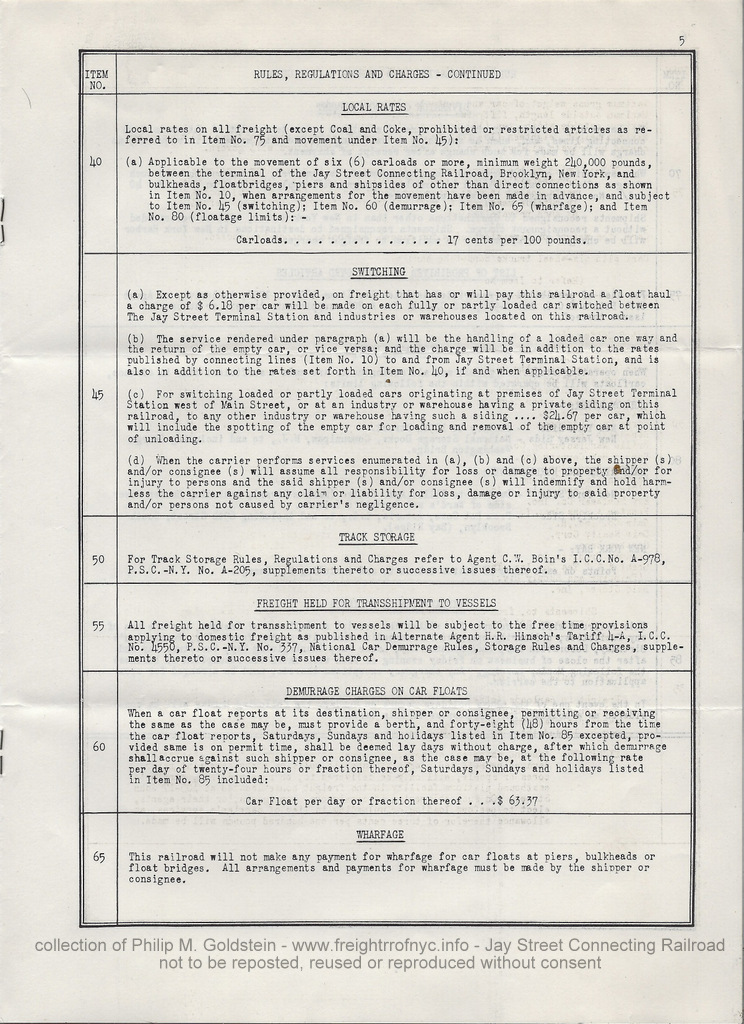 |
 |
A freight receipt in the Memorabilia Chapter below, shows eight boxes of soap being shipped from Kirkman & Sons to the Taber farm in Davenport Center, NY on April 3, 1944 via the Jay Street Terminal and the New York Central Railroad.
Another of the businesses utilizing Jay Street Terminal was E. W. Bliss; and they had a very unique place in the history of Jay Street operations and is worth mentioning.
Eliphalet Williams Bliss (b. April 12, 1836 - d. July 21, 1903)
began his business interests in two fields: as a press & die
manufacturer, and a significant torpedo / munitions manufacturer doing
contract work for the United States Navy. The Bliss Company operated its
torpedo manufacturing at the Brooklyn plant at Bush Terminal from the late
1800's until at least 1925. In 1903, when Eliphalet passed away, the Bliss
Company consisted of a total of eighty-five blocks in Brooklyn, and employed
a total of 13,000 people, between the press & die, precision equipment,
foundry and the torpedo manufacturing divisions.
.
| Eventually, a portion of the torpedo manufacturing facility
relocated to 135 Plymouth Street, and the block being bordered by Adams, John, Pearl & Plymouth Streets. This structure became the Chamber Paper Fiber Building.
It was this location that the E. W. Bliss manufactured machinery
The building that housed the munitions, is actually a "building
within
The aerial image seen at right, shows the individual inner
"gunpowder"
I can only surmise this design was the predecessor to
This building and its rail siding can
be seen in the Army Corp |
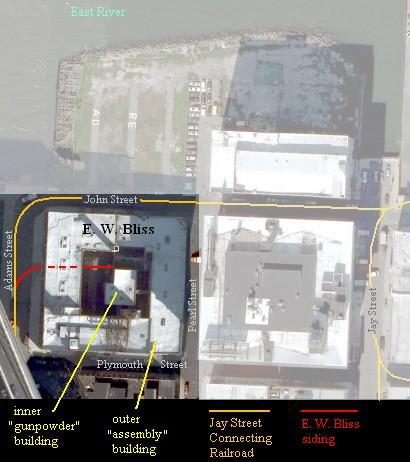 |
Torpedoes were manufactured at the Brooklyn plant, and then transported via the Long Island Railroad to Sag Harbor for testing, where the Bliss Company had a testing site for its torpedoes. Once there, the torpedoes were transferred to Navy vessels that were awaiting supplies or possible return to the war zone.
It is unconfirmed at this time, but highly likely; that the torpedoes were loaded onto freight cars on the E. W. Bliss rail siding, and those cars subsequently were loaded onto carfloats by the the Jay Street Connecting Railroad (just across the street). The carfloats would be transported to the Long Island Railroad float bridges in Long Island City.
We also know from builders records that E. W. Bliss purchased a Whitcomb 45DE27A model locomotive, c/n 60111 in January 1942; and we know that E. W. Bliss was equipped with a rail siding connecting to the Jay Street Connecting Railroad. Therefore it is very likely, the torpedoes were shipped by rail, originating at the Jay Street Terminal yard. What is not clear, is whether this E. W. Bliss locomotive was used in Brooklyn, or at the facility in Sag Harbor.
The E. W. Bliss foundry was located on Water Street. Before his death, E. W. Bliss was also vice-president of the Brooklyn Heights Railroad.
The following image, taken by the author from onboard the Lehigh Valley tugboat "Cornell", shows the E. W. Bliss structure in July 2008:
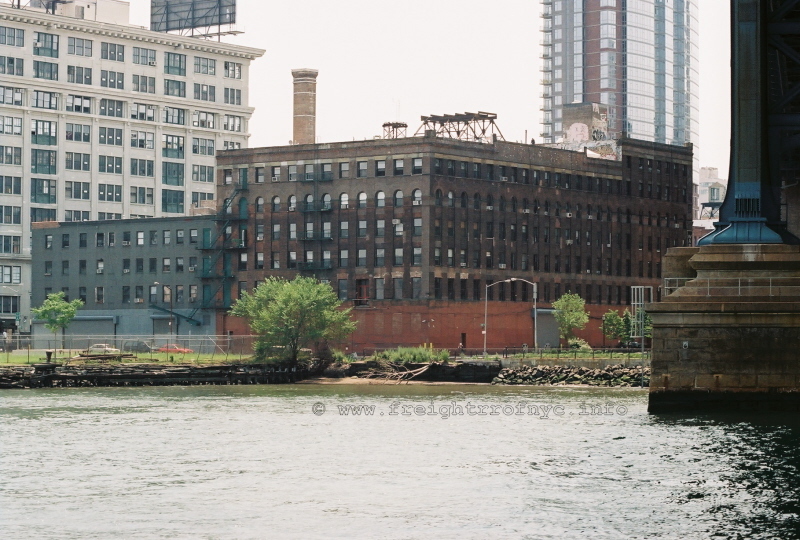
E. W. Bliss structure - July 12, 2008 - Brooklyn, NY
(The roll up gate seen between the streetlights and Manhattan Bridge tower
foundation
is the original track entrance.)
photo by author
added 30 May 2009
.
.
On December 22, 1910, the Public Service Commission issued permission for the construction of the Jay Street Connecting Railroad. December 22, 1910 edition of The New York Times carried the following article:
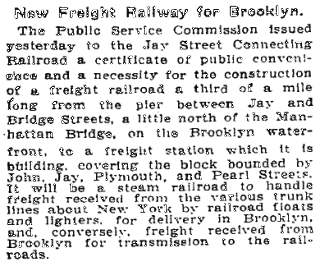
.
.
The Jay Street Connecting Railroad would come to have the majority of its trackage on city streets both between the Brooklyn and Manhattan Bridges (now known as DUMBO - Down Under Manhattan Bridge Overpass) as well as north of the Manhattan Bridge (Vinegar Hill).
The track layout of the Jay Street Connecting Railroad can be viewed in the Army Corp of Engineers "Port Facilities" map below. Most of track with the exception of the yards, was single track through city streets, with spurs into buildings and lofts. At its peak of operations; the Jay Street Connecting Railroad had a capacity of 120 cars (car capacities based on a standard 40' boxcar) and a single float bridge at the foot of Bridge Street.
The main railyard and facility was located at between Jay & Gold Streets and between John Street and the East River bulkhead. The open piers and float bridge were located at this yard and are indicated by key numbers 293, 294, 295 and 296 in the Army Corp of Engineers Port Facilities Map seen below.
The following image is generously provided from the collection of Tom Flagg. Click on the image below for an enlargement suitable for in depth examination, and a second copy containing notations. Please note: use the back arrow on your browser to return you here.
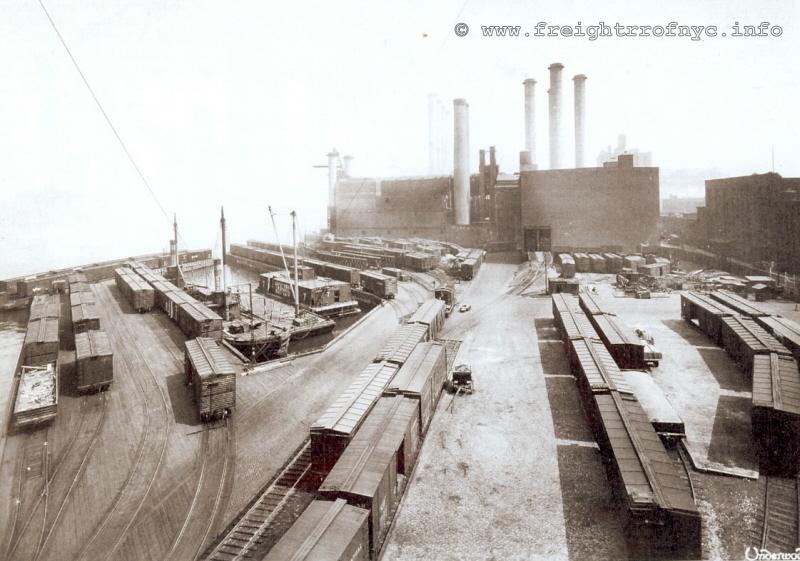
circa 1929
Looking east.
"Underwood" photo
T. Flagg collection
added 12 May 2009
.
In the photo above, we see a slightly unusual track arrangement leading into the Terminal Building. The two left most tracks ascend up a small incline to service the second floor of this warehouse. As unusual as this may be, Bush Terminal had a similar set up for one their buildings as well.
Another unusual facet of the Jay Street Terminal operation, can be seen in both the 1924 Fairchild Aerial and the 1929 Underwood photos. Jay Street had a habit of blocking their slips with carfloats. Note the carfloats moored perpendicular to the end of Pier 3 in both photos, which is essentially entrapping the marine equipment within that slip.
In 1941, Arbuckle / Jamison sold the Jay Street Terminal (piers / warehouse) operation to Moses Spatt and Joseph Wohl, who operated under the entity "Famous Realty". In 1945, Famous Realty would acquire all of the stock of the Jay Street Connecting Railroad as well as acquire the lease rights to operate the Jay Street Connecting Railroad trackage from the private owners of the sidings and spurs as well as the main line track from the City of New York.
The following images, were contained in the 1944 "Wyer Report". This report was commission by the heirs of the Arbuckle estate in an attempt to raise interest for the prospective sale of the properties.
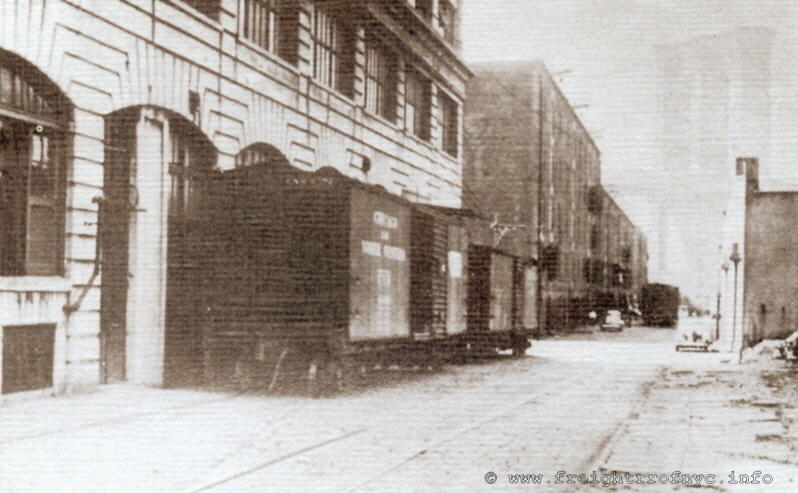
1944 - block 27 siding
On Plymouth Street looking west with Main Street intersection at the end
of second boxcar.
Note tower of Brooklyn Bridge in background.
"1944 Wyer Report"
courtesy T. Flagg
added 12 May 2009
.
.

ca. 1944 - front of Pier 4 piershed, Pier 3 & piershed
and slips
Looking east - track at bottom leads onto John Street.
Taken from roof of Block 2 (former Arbuckle Sugar Refinery)
"1944 Wyer Report"
courtesy T. Flagg
added 12 May 2009
.
.
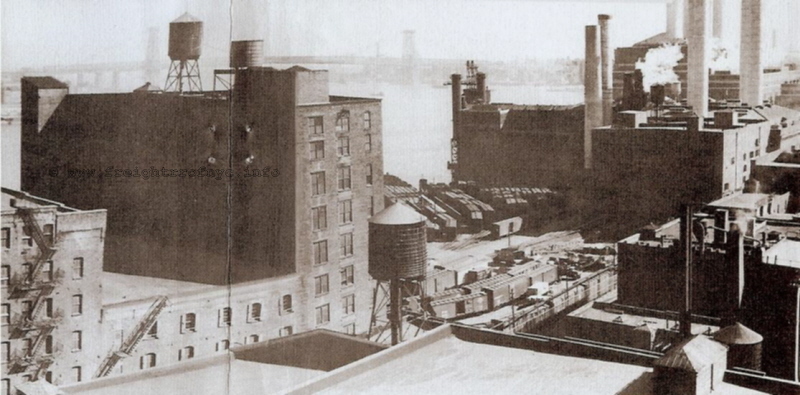
1944 - float bridge and yard seen from top of building
19 or 20
Looking east.
"1944 Wyer Report"
courtesy T. Flagg
added 12 May
2009
.
The following image was purchased off eBay in 28 February 2010. It is not dated (auction listing states circa 1920), nor is any photographer or repository cited. So far it is the only image I have located showing the New Dock Street Yard:
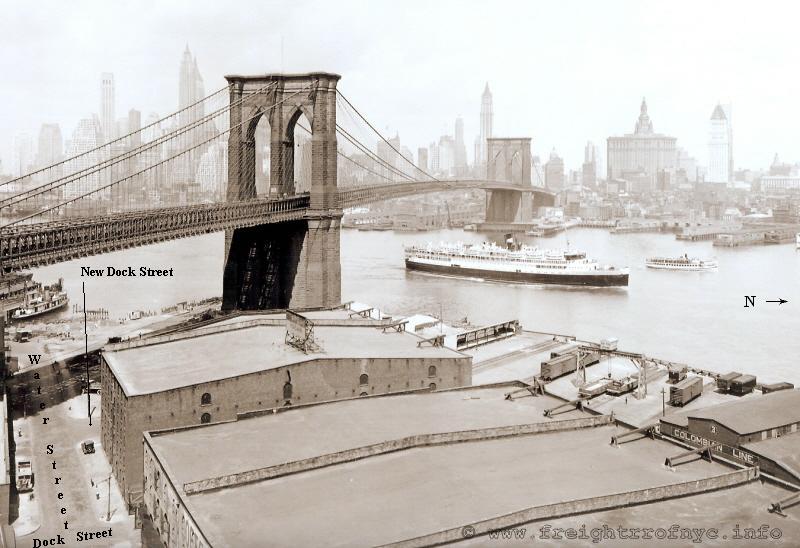
New Dock Street Yard - unknown date
Note the "Yuban" sign on roof of warehouse.
authors
collection
added 05 March 2010
.
.

New Dock Street Yard - unknown date
from left to right: freight transfer platform, team tracks, 40 ton overhead
gantry and Pier 3 "Columbian Line".
A 10 Ton overhead gantry is hidden behind the Pier 3 structure.
The piles of sand at the upper left corner of photo is not believed to be
part of the Jay Street Terminal operation
and believed to be the firm of N. Ryan Company.
authors
collection
added 05 March 2010
.
.
The smaller or west railyard was located between New Dock Street and Dock Street on the bulkhead. This yard housed the 40 Ton and 10 Ton capacity overhead gantries for oversize loads as well as a freight platform, and is denoted as key number 308 in the Army Corp of Engineers Port Facilities Map seen immediately below.
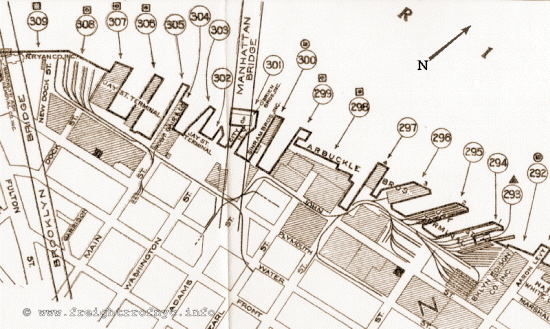
Army Corp of Engineers Port Facilities Map - unknown edition
.
.
The following track plan, which is from the 1944 Wyer Report, is much more detailed, and contains many notations pertaining to the occupants of the structures and businesses located along the Jay Street Connecting Railroad trackage.
Please click on the image below to see a large scale image. Use the back arrow on your browser to return you here.
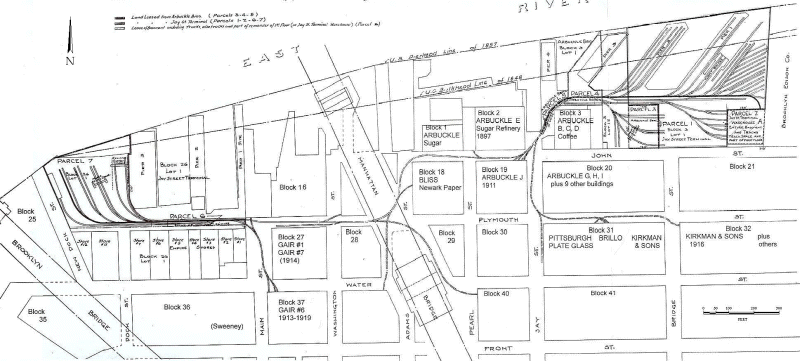
1944 Wyer Report Track Plan
courtesy of T.
Flagg
added 12 May 2009
.
Ironically, most of Jay Street Connecting Railroad's street trackage (girder rail) remains in place, still set in the original sett pavers (Belgian Block), with the exception of the floatbridge team tracks, main yard and engine house. A ConEd power plant and electrical switching yard now occupies this site.
The capacities of Jay Street Terminal in 1912 were located in the "Report of the Committee on Terminals and Transportation of the New York State Food Investigating Commission" published 1913; are as follows. Please note this table differs from those of the Bush Terminal and New York Dock, in the fact that the Jay Street Terminal did not exist in 1903, therefore those entries are blank.
|
stations |
| |. |
freight house |
| |. |
delivery track |
| |. |
storage track |
||||
|
1903 |
1913 |
| |
1903 |
1913 |
| |
1903 |
1913 |
| |
1903 |
1913 |
| Jay Street Terminal.. | Jay Street Terminal | | |
... |
39,000 |
| |
... |
... |
| |
... |
235 1 |
1 =
Includes delivery track
capacity.
In 1920, trackage was laid along Plymouth Street and fanned out to seven tracks to service the Arbuckle warehouses, as well as many private customers. As previously stated, freight cars would be brought directly off carfloats and would be spotted (placed) directly at warehouse locations for loading and unloading. The mainstay of the freight traffic would be Arbuckles Coffee, but this would be supplanted with other car load freight to and from the area.
Trackage to this date, extended just east of Jay Street and ran into the northwest corner of a building.
By 1929, trackage had been expanded greatly and the main track of the Jay Street Connecting still ran primarily down Plymouth Street with turnouts for other streets and building accesses.
However, the end termini of the railroad was now located at Dock Street on the west end and the main yard between Bridge and Duffield Streets on the bulkhead of the East River on the east end. The tracks, which were primarily "girder rail", (identical to that type of rail used in trolley track which are also set in pavement) were set in cobblestone paved streets, (more properly called "setts") of which many sidings branched off the "mainline" which lead into lofts and warehouses. Many of these warehouses remain today.
The 1944 Wyer Report states that the maximum length of freight cars accepted by the Jay Street Connecting Railroad is 52 feet, however freight cars consigned to or for the private siding must not exceed 42 feet 6 inches, due to the sharp radii of the private sidings. Furthermore, freight cars with six axles (six wheels on each truck / three axle trucks) could not be handled.
Upon the closure of Jay Street Terminal, the main railyard and property was purchased by Consolidated Edison (a/k/a ConEd), the electric utility company in the New York City area and is now a transformer switching yard.
The New Dock Street Yard is now the Empire Fulton Ferry State Park.
.
Early images through 1929 of the Jay Street Terminal show a pontoon supported wood Howe Truss float bridge in service.
Upon my receipt a few years ago of a 1958 photo of locomotive #7511 (seen below in locomotive chapter), it clearly showed a pony plate girder, so I naturally concluded this was a "simple" pony plate girder float bridge and listed it as such on this page. Boy, was I wrong.
Upon reviewing Tom Flagg's article in Transfer #44 in May 2009; I took note that the girders were of different heights in the 1944 Wyer Report photo. At first I thought, would the cash strapped Jay Street retrofit two steel plate girders in place of the outer wood trusses on the original Howe Truss bridge? While I guess it could be done, Paul Strubeck felt they did not.
Recalling the #7511 image in my collection, I immediately "dug it out" and grabbed a magnifying glass. Low & behold, in spite of the image being a little blurry, there was clearly a steel truss down the center of the bridge, which was slightly taller than the outer plate girders. Note the height and thickness of this center girder (compared to the outer girders below) in the bottom two images under the circa 1929 Howe Truss image.
This is my first encounter with this type of float bridge, and it is without a doubt quite an unusual design when one is used to either Howe Trusses, or "pure" steel Pony Truss or steel Pony Plate Girder float bridges. This design is a kind of composite of both designs, and for the duration and until this name is corrected, will be called such here.
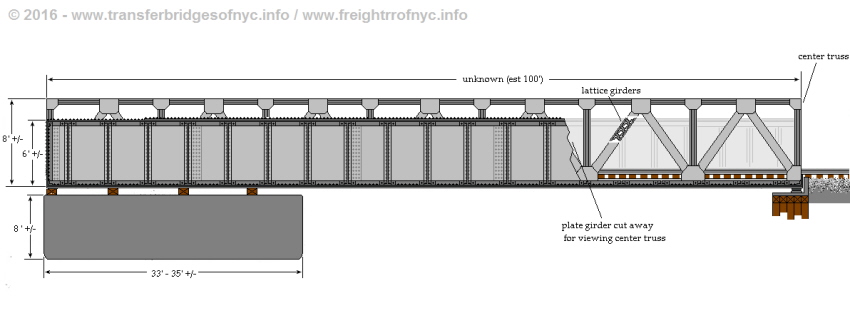
.
Upon conferring with Joe Roborecky, he feels as I do; that the Jay Street Terminal being such a small operation with limited financial assets, took the cost effective option by retrofitting the original wood Howe Truss float bridge with steel girders and trusses, and retaining the original deck and substructure. Whether this is even feasible from an engineering / construction stand point, I honestly do not know.
Logistically speaking, it would appear easier to just "swap out" the float bridge than reconstruct the Howe Truss.
In any event, we can safely conclude that the Jay Street Terminal Howe Truss float bridge was either replaced completely or modified to the composite float bridge discuss above. The question remains on what date did this occur?
|
|
|
| . | |
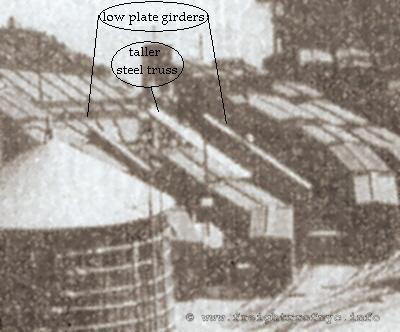 |
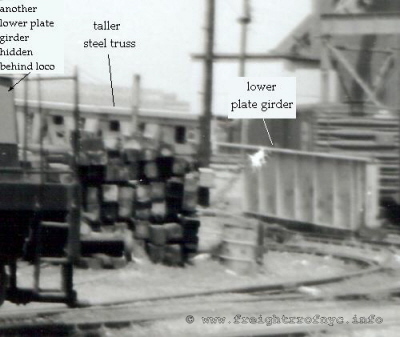 |
|
1944 - "composite" Steel Truss & Pony Plate Girder |
1958 - "composite" Steel Truss & Pony Plate Girder |
.
The Jay Street Connecting Railroad would operate until June 27, 1959; and during its existence it would operate an eclectic roster of equipment, with several "one-of-kind" units of demonstrator parentage.
.
#1 & #2
In 1910 at the formation of railroad operations, Jay Street Terminal purchased a Baldwin Locomotive Works steam powered sidetank (sloped style) locomotive of 0-6-0T wheel arrangement and was numbered #1. The following year, a second locomotive of almost identical build and would be numbered #2.
What with the unsatisfactory performances of primitive internal combustion-electric locomotives tried (#3 in 1913 and #4 in 1916) it appears that these steam locomotives would remain as primary motive power through circa 1930. Also at an undetermined date, the Jay Street Terminal would be renamed Jay Street Connecting Railroad and the steam locomotives livery would be changed as such.
In 1931, one of these steam locomotives: #1; would be sold to the New York Dock Railway which operated their own terminal not even a mile south. It would be renumbered #41 and that is where it would operate for several more years. Locomotive #2 however was not as fortunate as its sister and would be stored on Jay Street property beginning in 1931, to eventually be scrapped in 1939.
To date only one known image is known of the steam locomotives and it is with great enthusiasm, shown below. We are greatly indebted to William Longo, of whom contacted the author. He was seeking permission to use build information for the locomotives in an auction website description, and quite honestly our communication led to the images outright and direct purchase.
.
#3 (ex- East Erie Commercial #1006)
The gas / oil-electric locomotives that would come to replace the steam locomotives of the Jay Street Connecting Railroad operation, had to be the most unique and diverse of the Brooklyn Rail-Marine Terminals, with Jay Street having purchased several experimental / demonstrator locomotives.
Locomotive #3 was a center boxcab switcher, and most peculiar in appearance. This unit looked more like a shack on a flat car than an actual locomotive, and quite honestly resembled the unpowered Long Island Rail Road float reacher cars or some home shop constructed trolley motors, and with no regard given whatsoever to aesthetics. Its early ownership history is equally as odd, resembling that of a troubled child bouncing from foster home to foster home.
This locomotive would be built by General Electric in August 1913 assigned construction number (c/n) 3765; and used as a demonstrator locomotive and prototype test platform. It was lettered for the General Electric subsidiary East Erie Commercial Railroad and numbered #1006. The East Erie Commercial Railroad (EEC) is a small switching railroad that services the General Electric locomotive construction facilities located in Erie, Pennsylvania. It still exists as of 2025.
#3 looked like a box on a flat car. Weighing 45 tons, it was powered by a gasoline General Electric GM16 engine which developed 175 horsepower, and four GE205D traction motors. After testing, it was sold to the Jay Street Connecting Railroad, and renumbered #3 in September 1916.It has also been stated that allegedly around 1935, #3 would be stripped of its cab and engine, and used as a "reacher car" for the unloading / loading of carfloats. However, photographs below taken after 1935 and as late as 1948 show this unit still equipped with its cab. So at this time, is it obvious that that information is incorrect and most likely the engine and traction motors were removed but not the cab. Furthermore, in what little photos exist of other Jay Street locomotives or operations do not show this float reacher car.
.
#4 (to become East Erie Commercial #11)
A fact worth noting in regards to both diesel locomotive and Jay Street Connecting history, is that the Jay Street Connecting Railroad purchased the first diesel-electric locomotive to be built and sold commercially. This General Electric locomotive would become Jay Street Connecting Railroad #4 and had the appearance of a "boxy" steeple cab.
It was originally believed that this locomotive was a one of a kind unit, but in referencing "The Diesel Spotters Guide", Second Edition (1973), by Jerry Pinkepank; reveals that there were actually three of this type locomotive constructed:
"Experimental Diesels of 1918"
"General Electric produced the first known diesel locomotives in the U.S.A. in 1918. Three machines were constructed, of which one was an armored car for the Army, one was for an unknown industrial user in Baltimore, and one for the Jay Street Connecting.
From dates on the builders photos it is believed the Jay Street unit was first of the three. As far as is known, the units were not a commercial success and may have been returned to GE for scrapping shortly after delivery. No positive data on disposition of the units has been obtained however."
.
According to this same reference; the original prime mover for this locomotive was a 200 hp V8 engine designed by Hermann Lemp, Henri Chatain and W. E. VerPlanck of General Electric of which pictures exist of this engine. Two cylinders were cast "en bloc" under each of the heads. It appears from the photo of the engine, each of these two cylinders was also "siamesed", meaning that each of the two cylinders shared a common cylinder wall between the cylinders, instead of a hollow cooling passage common of most internal combustion or compression ignition engines.
This locomotive; c/n 6206; was built with a GM50 diesel engine rated at 200 horsepower, and HM820C traction motors. The completed locomotive weighed 55 tons, and had the appearance of a steeple cab electric locomotive with and extra length cab compartment.
After only six months however, Jay Street Connecting returned this locomotive to GE as unsatisfactory. While the locomotives' Jay Street Connecting history ends here, the author feels it is pertinent to list the following subsequent history for clarification and obviously, historical purposes.
The locomotive would be stored for approximately three years at General Electric where it subsequently was repowered with a Sterling "Dolphin" 6 cylinder gasoline engine rated for 250 hp, and became East Erie Commercial #2 in September 1922. General Electric then used it as a testing platform and experimental unit in developing better control and propulsion systems.
In August 1934, the locomotive would be completely reconstructed over a period of two years by GE. The frame, trucks with original motors and original cab were fitted with new hoods and two 165 hp Waukesha-Hessellman spark ignition oil engines. This rebuild was completed April 1936 and the locomotive renumbered again to East Erie Commercial #11 and new weight registered as 58 tons.
Due to its short tenure on the Jay Street Connecting, only the GE builders photo is known showing the locomotive in Jay Street Connecting livery. However at least one photo of it dated 1937 (following its second rebuild) as East Erie Commercial #11 is known (and can be seen on page 122 of "Centennial Treasury of General Electric Locomotives, Volume 1" by O. M. Kerr).
.
#5
Locomotive #5 was a typical end cab switcher, with weight stated as 57 tons, and built by American Locomotive and General Electric. The model was designated a HH300 (High Hood - 300 hp)
This locomotive was purchased used and it is an ex-military unit (US Navy - Mare Island #5) and would serve its second owner well until the end of operations.
According to Diesel Spotters Guide (Second Edition); this locomotive was a direct successor to boxcab design #300 (below), using the same machinery under hood (although cylinder size is now listed as 9½" bore x 10½" stroke).
A total of seven units of this design were constructed: with two units going to the Lehigh Valley Railroad and five going to the US Navy. Of special note, is that the Diesel Spotters Guide states:
"On the early units the cab end was regarded as front."
This is typical of that era; but as operating practice and locomotive construction throughout the United States has evolved, the locomotive cab is now considered the back of the engine.
.
#300
Locomotive #300 was a boxcab switcher in the purest sense, and would also serve the Jay Street Connecting Railroad's operation until the end. It was also built as a demonstrator model, and built by American Locomotive.
#300 would be sold to Jay Street Connecting in May of 1931, possibly to remain compliant to the initial ratification of the Kaufman Act.
You can read the comprehensive history of all steam locomotive restrictions for the City of New York, beginning 1834 and ending with the Kaufman Act and its repeal on the main page of this website: Steam Locomotive Regulations within the City of New York. It is very much worth a read, because there are misconceptions about the Kaufman Act, i.e. such as it was ruled unconstitutional in 1926 and repealed in 1930.
Specifications refer to this locomotive as a 60 ton 300 hp boxcab. This was the only locomotive of this model built, with the prime mover being recorded as a MacIntosh & Seymour engine with a 9 1/2" bore x 10" stroke. The majority of the cylinder design (with a minor 1/2" variation), would be incorporated into ALCo's 244 and 251 series engines.
With the acquisition of the ALCo builders photo / data card, we see a small discrepancy: the data card shows cylinder stroke to be at 10 1/2", (not 10" as previously stated). We can now also add a few more other particulars to this locomotive:
| order number: | S-1699 |
| class: | 401-OE-129 |
| weight: | 128,500 lbs |
| engine: | 6 cylinders, 9 1/2" bore x 10 1/2" stroke, 300 hp |
| traction motors (four): | GE-297-A |
| gear ratio: | 4.43 |
| wheelbase: | 23' 2" |
| wheel diameter: | 38" |
| journals: | 5 1/2" x 10", 7" centers |
| tractive effort: | starting: 38,500 lbs 2.8 mph: 25,720 lbs 3.7 mph: 19,040 lbs |
| top speed: | 40 mph |
.
#7511
Locomotive #7511, was a Vulcan 60 Ton centercab switcher, similar in appearance to a General Electric 44 ton unit.
This locomotive was also another ex-military unit (US Army - Fort Hancock, NJ)
Photographs taken in 1959 after Jay Street Terminal ceased operations, show locomotives #5 and #300 enroute to and at Patapsco Scrap in Maryland; yet #7511 is nowhere to be seen. However a photo of #7511 below, shows it in operation as late as July 1958.
It was then learned that this #7511 would be sold to Houdaille Construction Materials (chimney rock quarry) located in Martinsville, NJ. It appears #7511 was scrapped on their property after several years of use.
As far as is known, not a single one of Jay Street Connecting Railroads locomotives would survive. This is particularly troubling from a historical standpoint, as several were engineering testaments to the development the sign of things to come: diesel electric locomotives.
.
.
|
|
| .
. |
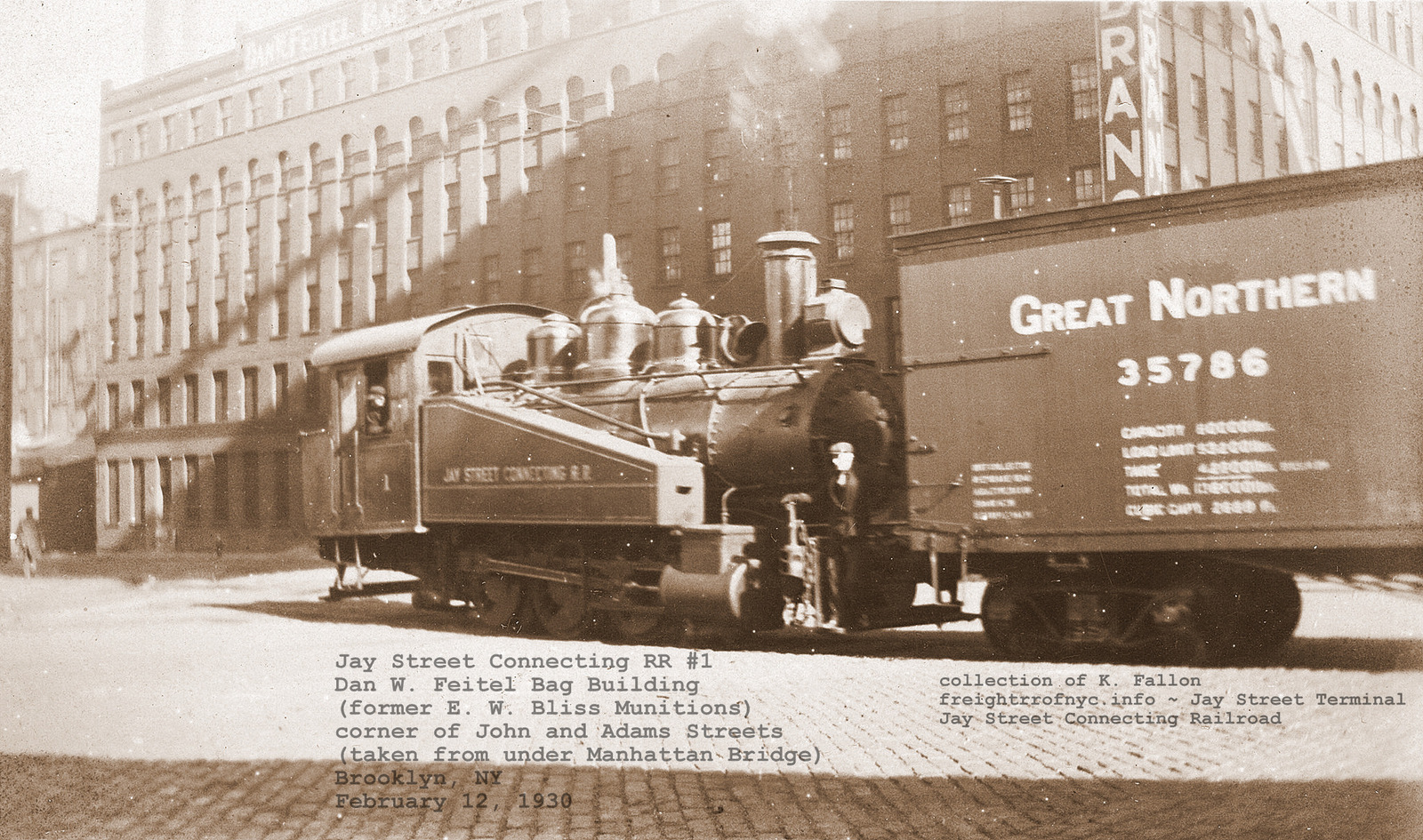 |
| .
. |
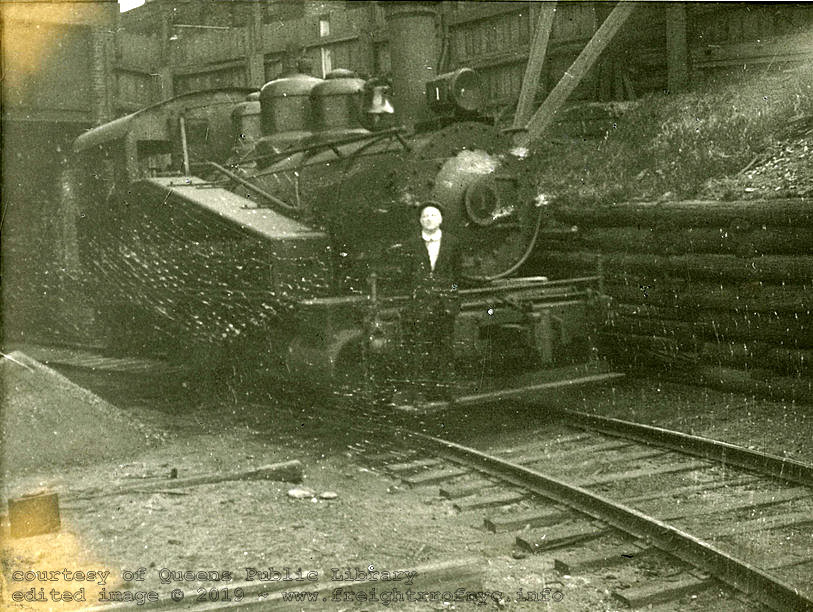 #1 - 1936 William J. Rugen photo courtesy of Queens Public Library Digital Archives images correction by author authors collection added 21 May 2019 |
| .
. |
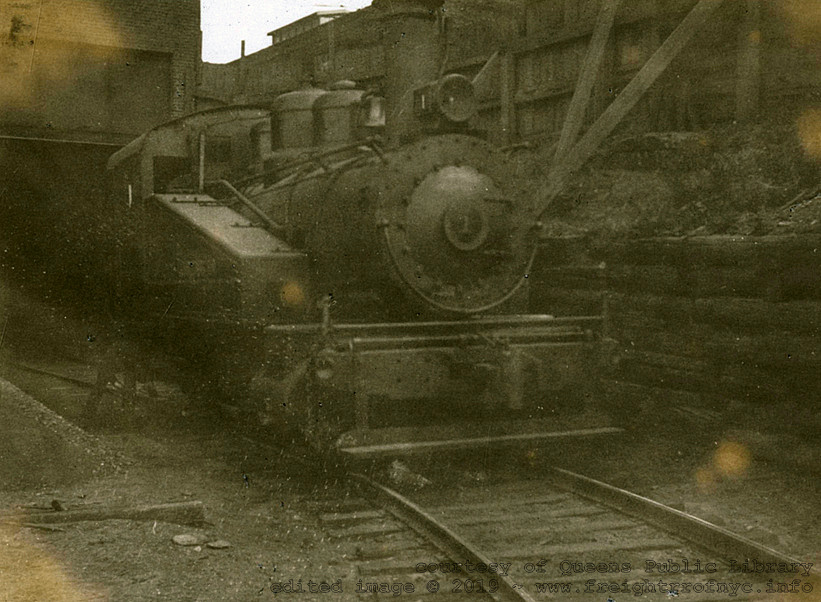 #1 - 1936 William J. Rugen photo courtesy of Queens Public Library Digital Archives images correction by author authors collection added 21 May 2019 |
| .
. |
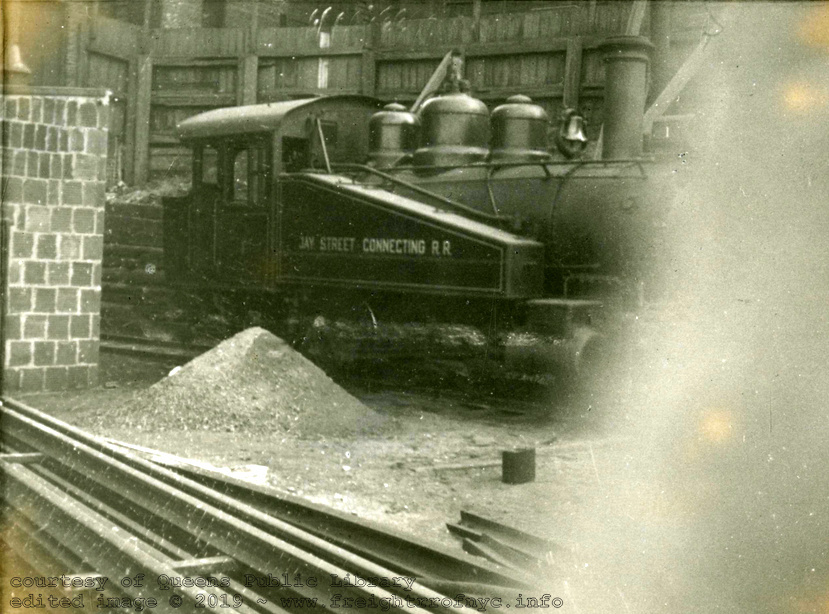 #1 - 1936 William J. Rugen photo courtesy of Queens Public Library Digital Archives images correction by author authors collection added 21 May 2019 |
| .
. |
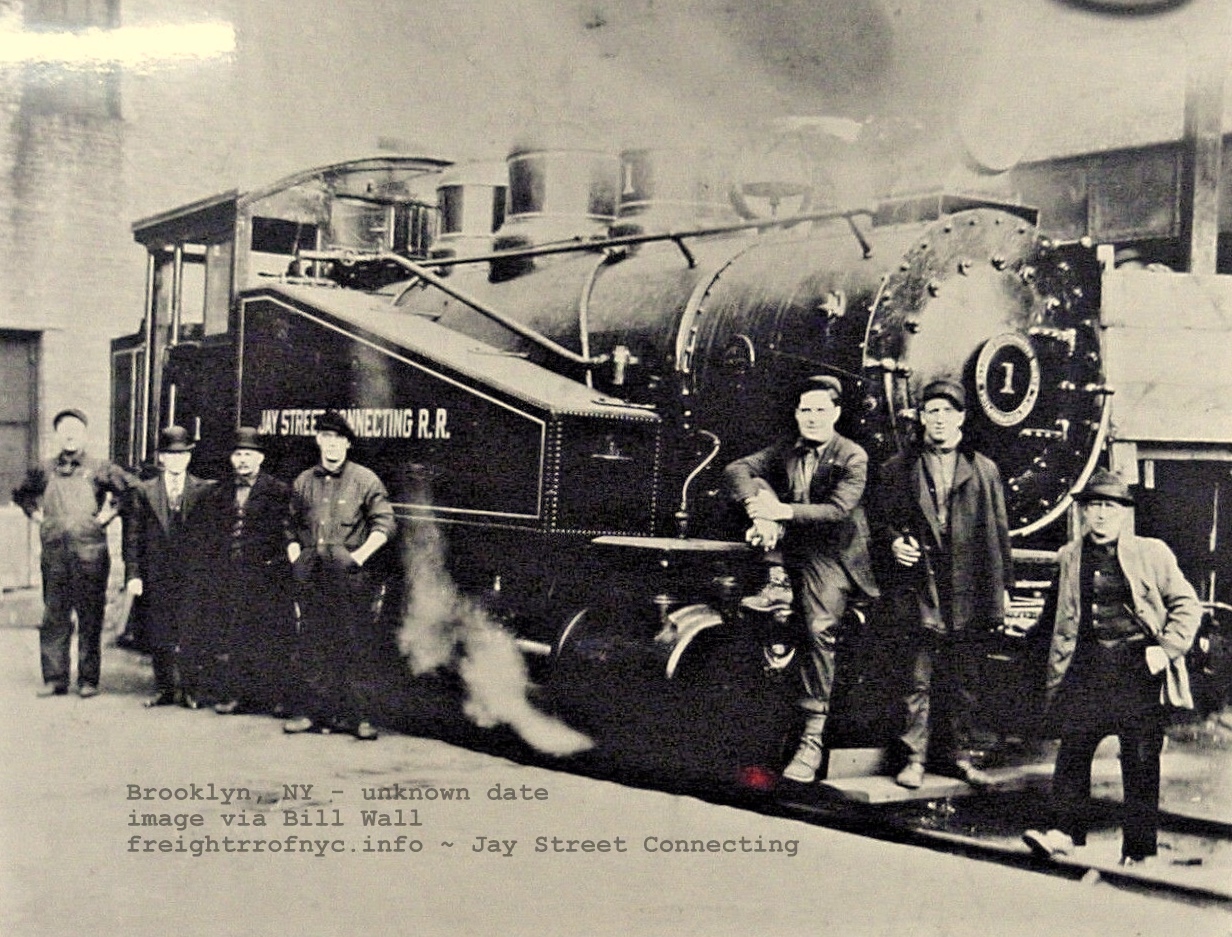 #1 - unknown date unknown photographer courtesy of Bill Wall added 11 January 2023 |
| .
. |
 #2 - unknown date unknown photographer courtesy of Bill Wall added 11 January 2023 |
| .
. |
|
|
| .
. |
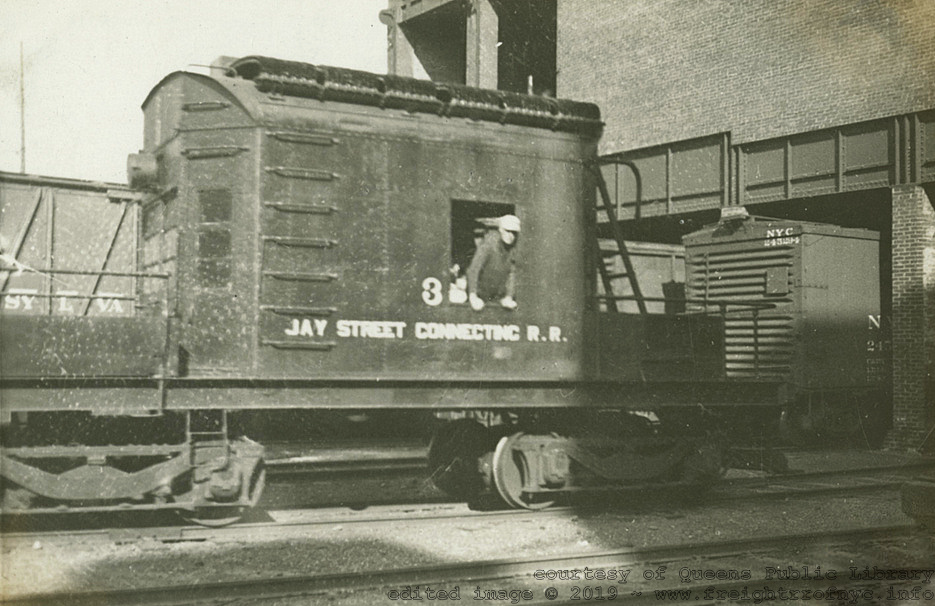 #3 - 1936 William J. Rugen photo courtesy of Queens Public Library Digital Archives images correction by author authors collection added 21 May 2019 |
| .
. |
|
|
| .
. |
|
|
| .
. |
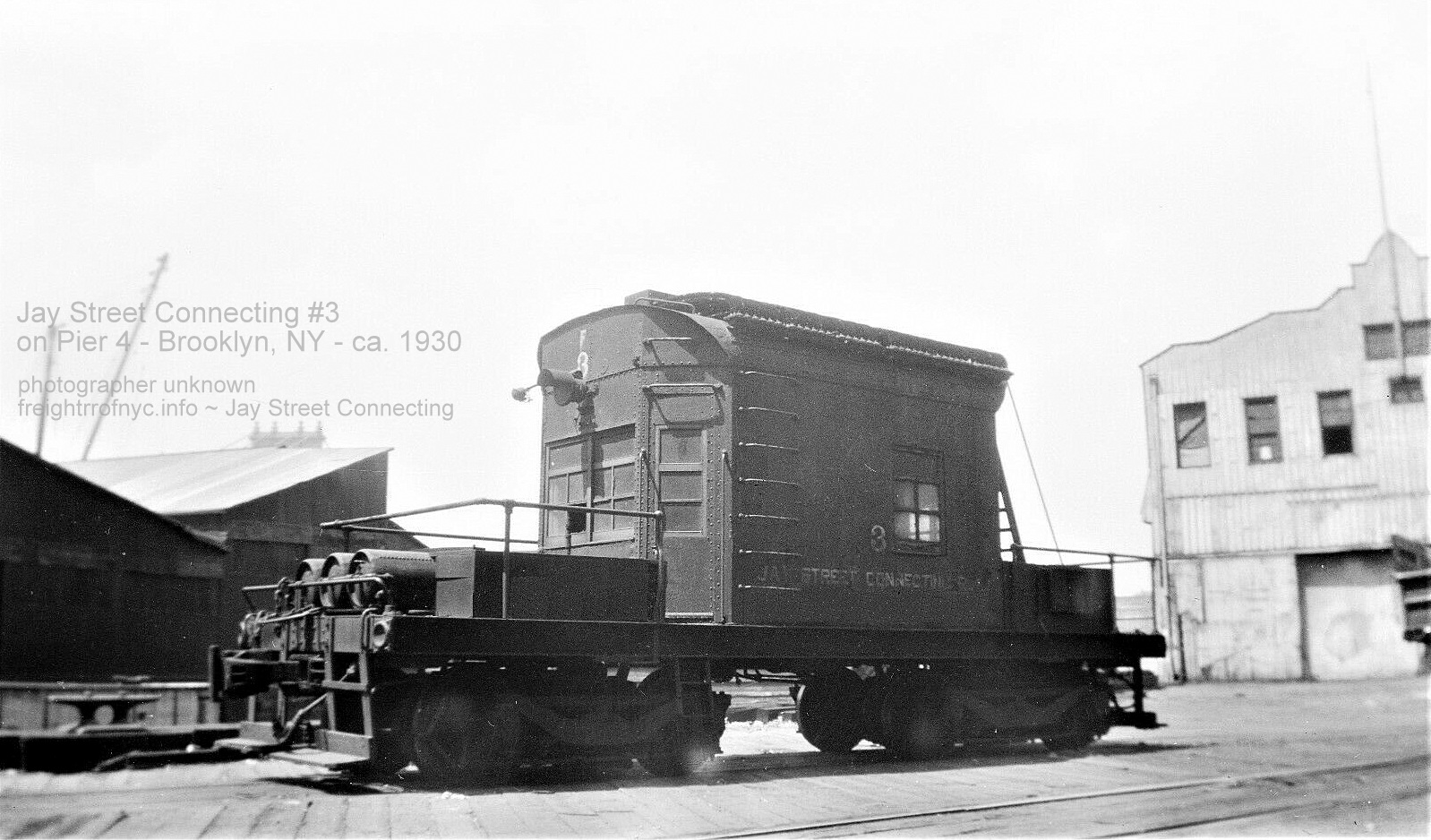 #3 - unknown date unknown photographer |
| .
. |
|
|
| .
. |
|
|
| .
. |
|
|
| .
. |
|
|
| .
. |
|
|
| .
. |
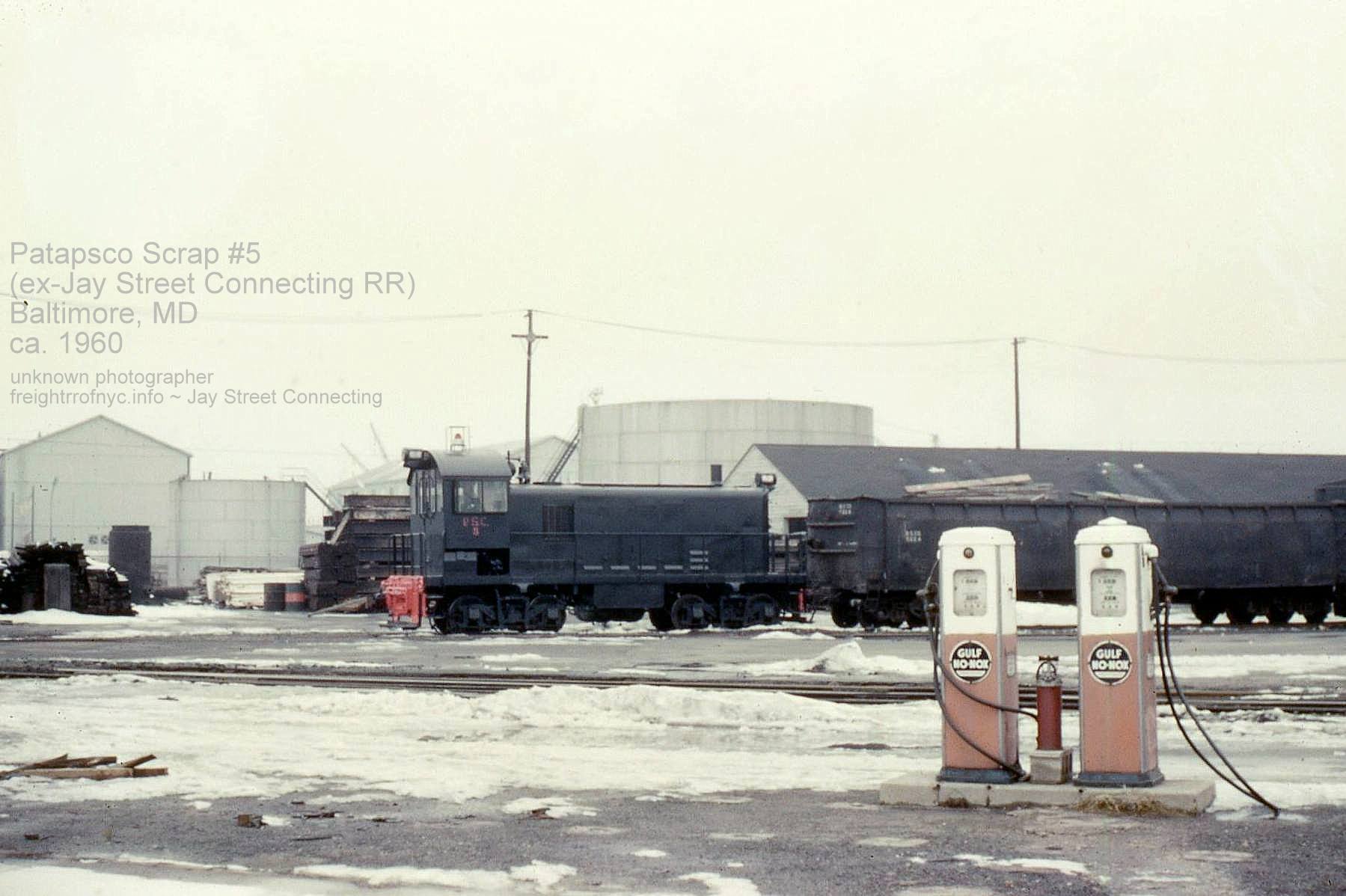 #5 - ca. 1960
Patapsco Scrap #5 (ex-Jay Street Connecting #5) - Baltimore, MD SMU - E. L. Degolyer Library archives author's collection |
| .
. |
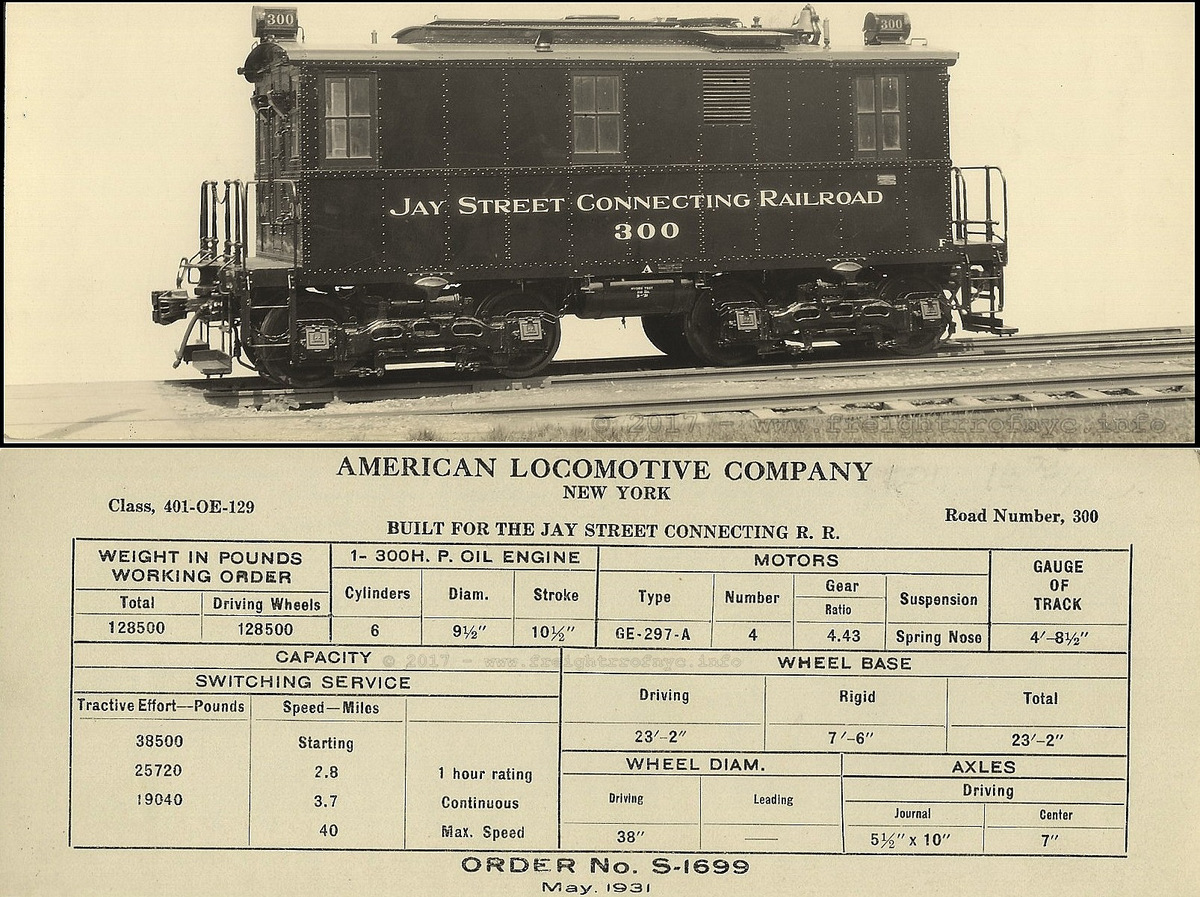
#300 - American Locomotive Company Builders Photo -
May 1931
added 30 November 2017 |
|
.
. |
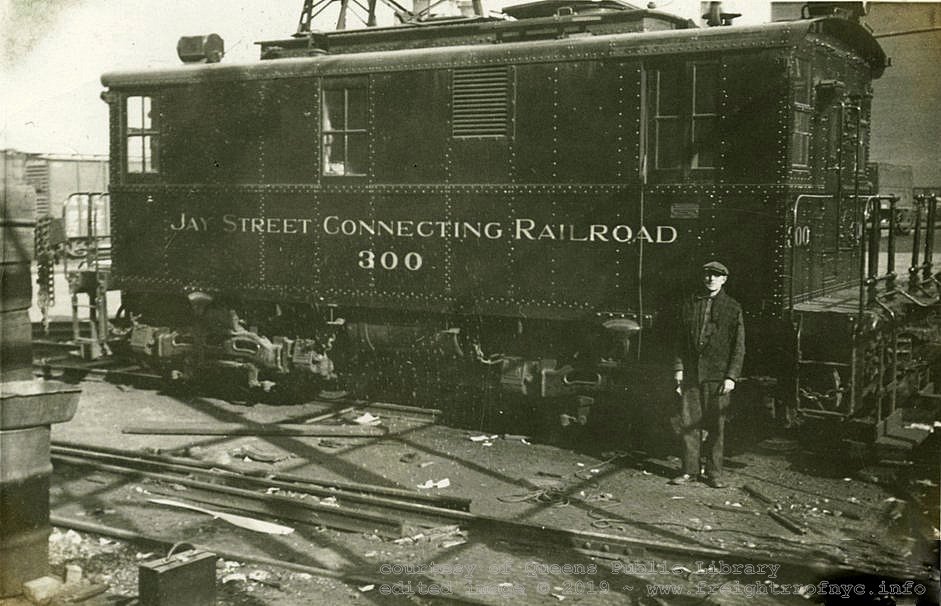 #300 - 1936 William J. Rugen photo courtesy of Queens Public Library Digital Archives image correction by author authors collection added 21 May 2019 |
| .
. |
|
|
| .
. |
|
|
| .
. |
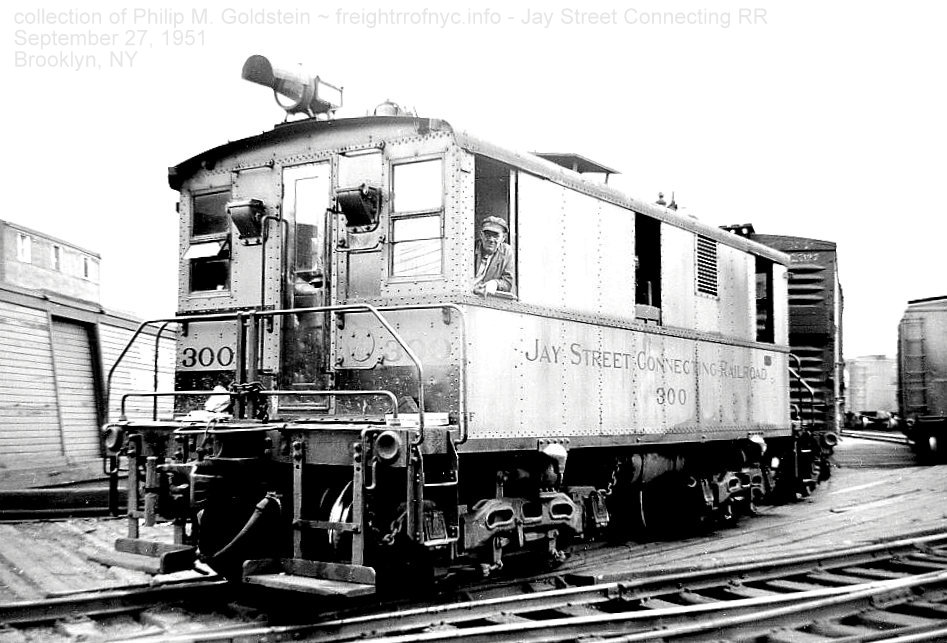 #300 - September 27, 1951 unknown photographer copy print from eBay |
| .
. |
|
|
| .
. |
|
|
| .
. |
|
|
| .
. |
|
|
| .
. |
|
author's collection |
| .
. |
|
|
| .
. |
|
|
| .
. |
|
|
| .
. |
|
|
| .
. |
|
|
| .
. |
|
|
| .
. |
|
|
.
.
Jay Street Connecting Railroad
Locomotive Roster
| number / name | builder |
c/n |
build date |
gauge |
wheel arrangement or model |
wheel dia |
cylinders |
acquired |
disposition |
notes |
ref |
| #1 | Baldwin | 27255 | 1/1906 | std. | 0-6-0T | 46" | 19" x 24" | new | sold | to NYD 1931 - became #41 |
[2] |
| #2 | Baldwin | 30480 | 3/1907 | std. | 0-6-0T | 46" | 19" x 24" | new | scrapped | stored 1931 scrapped 1939 |
[2] |
| #3 | GE | 3765 | 1913 | std. | B-B | demo 8/1916 4/1919 |
General
Electric,
cab(?) & motor removed, used as float reach car until ca. 1935returned 8/1918: General Electric and rebuilt - 8/1918 sold to: US Army #34, returned to General Electric sold 4/1919: |
built as East Erie Commercial #1006 (General Electric demonstrator) 404-G-90-4HM820A 175 hp 45T rebuilt to 404-G-90-4-GE-205D 350 hp 50T centercab demonstrator see [a] below |
[21] | ||
| #4 | GE | 6206 | 9/1918 | std. | B-B | 6/1917 11/1918 |
GE rebuild of c/n 3795 - East
Erie Commercial #1006 11/1918: to Jay Street Connecting #4 4/1919: returned to GE sat until 1922 rebuilt with Sterling “Dolphin” 6 cyl gas engine 9/1922: became East Erie Commercial #2 8/1934: returned to General Electric and rebuilt with (2) Waukesha-Hessellman Spark Ignition Oil engine (330 hp total), to 58T 4/1936: became East Erie Commercial #11 |
404-O-110-4HM820 LS404-O-110 55T GM16-C6 200hp steeplecab demonstrator see [b] below |
[21] | ||
| #5 | ALCo - GE | 68698 | 6/1935 | std. | B-B | 12/1955 | Patapsco Scrap Baltimore, MD 5/1959 |
HH-300, 57 Ton ex-USN #5 Mare Island, CA ex-NAD #5 Hingham, MA [c] |
[1] [7] |
||
| #300 | ALCo | 68488 | 5/1931 | std. | B-B | 38" | 1931 | Patapsco Scrap Baltimore, MD 5/1959 |
300 hp demonstrator boxcab |
[1] | |
| #7511 | Vulcan | 4394 | 2/1944 | std. |
B-B |
1955 | to: Birmingham Rail & Locomotive (Dealer) Birmingham, AL; sold to: Houdaille Construction Materials #7511 (chimney rock quarry); Martinsville NJ; |
centercab 60T ex-US Army Fort Hancock, NJ |
[8] |
Locomotive Footnotes:
| [a] | Built | 1913 | East Erie Commercial (GE Co. Erie, PA) #1006, may have been built many months earlier than recorded, no supporting documentation remains. Built with one GM16-C6 engine and four 205D motors. Used as demonstrator. |
| Sold | 9/1916 | Jay Street Terminal #3. | |
| Returned | 8/1918 | rebuilt with four HM-820A motors, and weight increased to 50 tons. | |
| Leased | 10/1918 - 1/1919 | US Army Ordnance Dept at Aberdeen Proving Grounds, MD | |
| Reacquired | 4/1919 | Jay Street Connecting (again) retired | |
| Rebuilt | < 1935 | cab(?) stripped and frame (w/ traction motors) used as a reach car. | |
| . | |||
| [b] | Shipped | 10/1918 | Jay Street Connecting #4 |
| Returned | 4/1919 | Stored at GE Erie until 1922 | |
| Rebuild | 1922 | Repowered with a Sterling "Dolphin" six cylinder gasoline engine and sent to East Erie Commercial RR in 9/1922 as #2 | |
| Rebuild | 8/1934 | Partially dismantled. Frame, trucks w/ original motors and original cab utilized in rebuild with new hoods and two 165 hp Waukesha-Hessellman spark ignition oil engines. ............................................. | |
| Completed | 4/1936 | assigned EECRR #11 when completed. New weight 58 tons. | |
| Retired & Scrapped | 8/1940 | ||
| . | |||
| [c] | model: length: height: width: weight: engine: hp: max rpm: min rpm: gear ratio: traction motor: starting tractive effort: running tractive effort: airbrakes: min turn radius: trucks: journals: fuel cap'y: oil cap'y: water cap'y: sand: coupler: |
HH300 (High Hood 300 hp) 32' 8" 13' 9.5" 9' 6" 114,000 lbs MaCintosh & Seymour 330 6L 300 700 250 68:16 General Electric HM 838 (x4) 36,000 lbs. 7,900 lbs. at 10 mph Westinghouse 14EL 57' Blunt type B, rigid suspension 5" x 9" plain bearing 635 gals 80 gals 50 gals 27 cubic ft. radial |
|
.
.
The Jay Street Connecting would also operate various steam powered lighters and tugboats for the movement of carfloats.
Of those tugboats, the "John A. McCormick" was one of the largest tugboats to have seen service in New York Harbor.
|
|
| .
. |
|
|
| .
. |
|
|
| .
. |
|
|
| .
. |
|
|
| .
. |
|
|
| .
. |
|
|
| .
. |
|
|
|
.
. They also operated another early piece of unusual marine equipment, which was their floating coal transfer: |
|
|
.
.
.
.
Jay Street Connecting Tugboat, Steam
Lighter, & Carfloat Roster
(please note: vessels are in order of
acquisition).
|
|
||||||||||||||||||||||||||||||||||||||||||||||||||||||||||||||||||||||||||||||||||||||||||||||||||||||||||||||||||||||||||||||||||||||||||||||||||||||||||||||||||||||||||||||||||||||||||||||||||||||||||||||||||||||||||||||||||||||||||||||||||||||||||||||||||||||||||||||||||||||||||||||||||||||||||||||||||||||||||||||||||||||||||||||||
Tugboat Footnotes:
The following specifications are taken from Johnson's Steam Vessels, 1920
|
|
|
|
||||||||||||||||||||||||||||||||||||||||||||||||||||||||||||||||||||||||||||||||||||||||||||||||||||||||||||
|
|
|
|||||||||||||||||||||||||||||||||||||||||||||||||||||||||||||||||||||||||||||||||||||||||||||||||||||||||||||
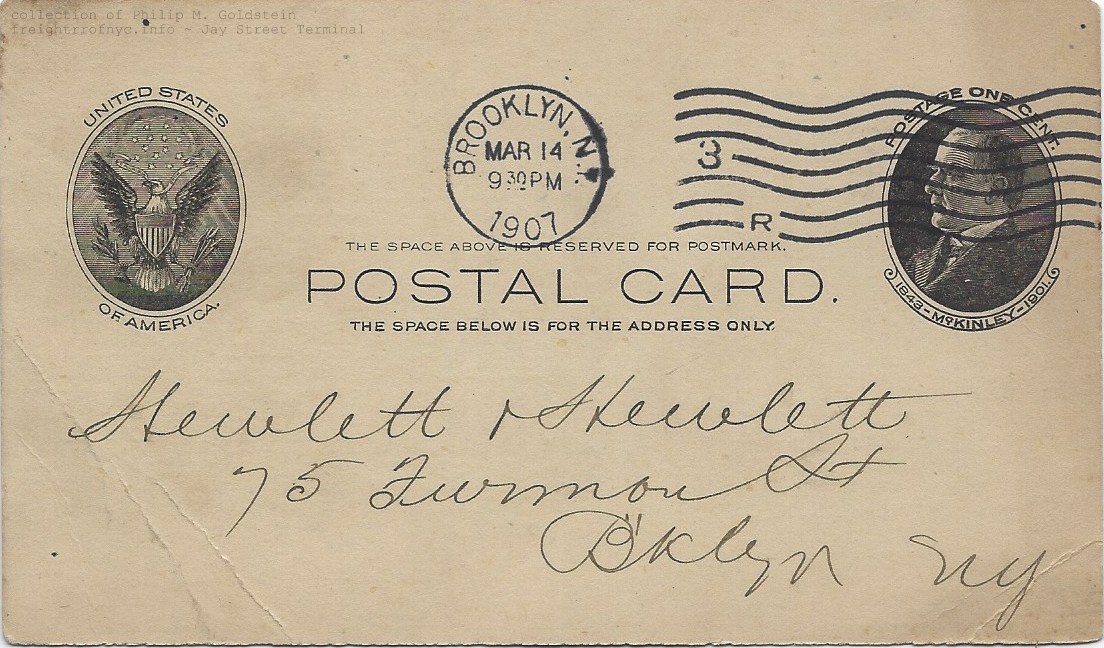 |
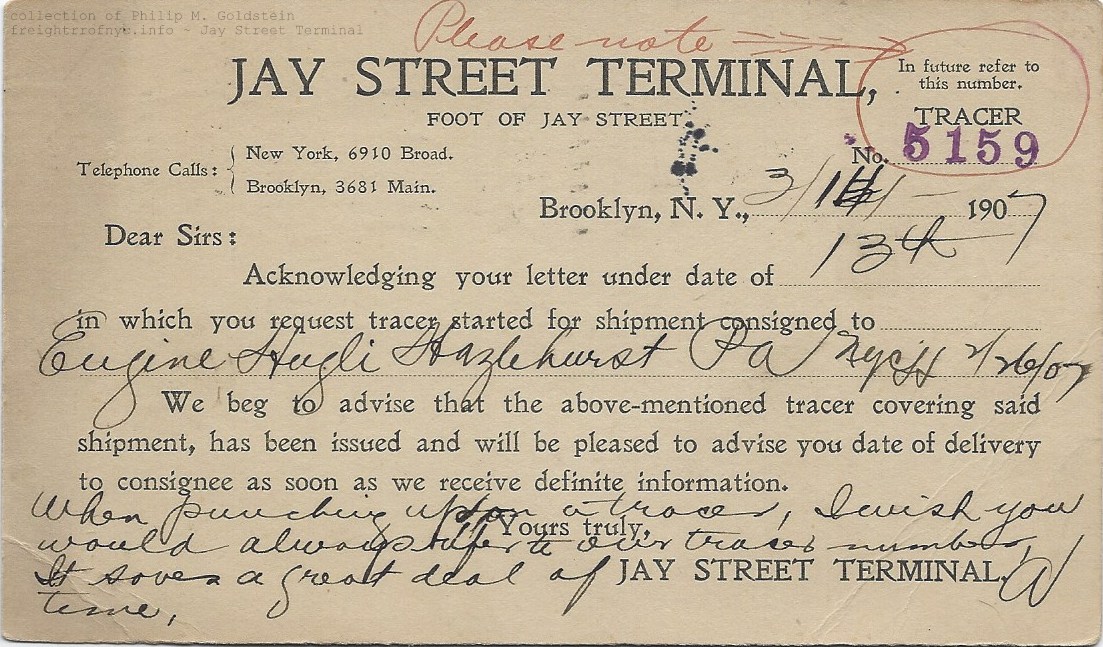 |
| Freight Tracer postcard - March 13, 1907 Hewlett & Hewlett was a coffee roaster located at 75 Furman Street in Brooklyn. authors collection added 10 November 2022 |
|
 |
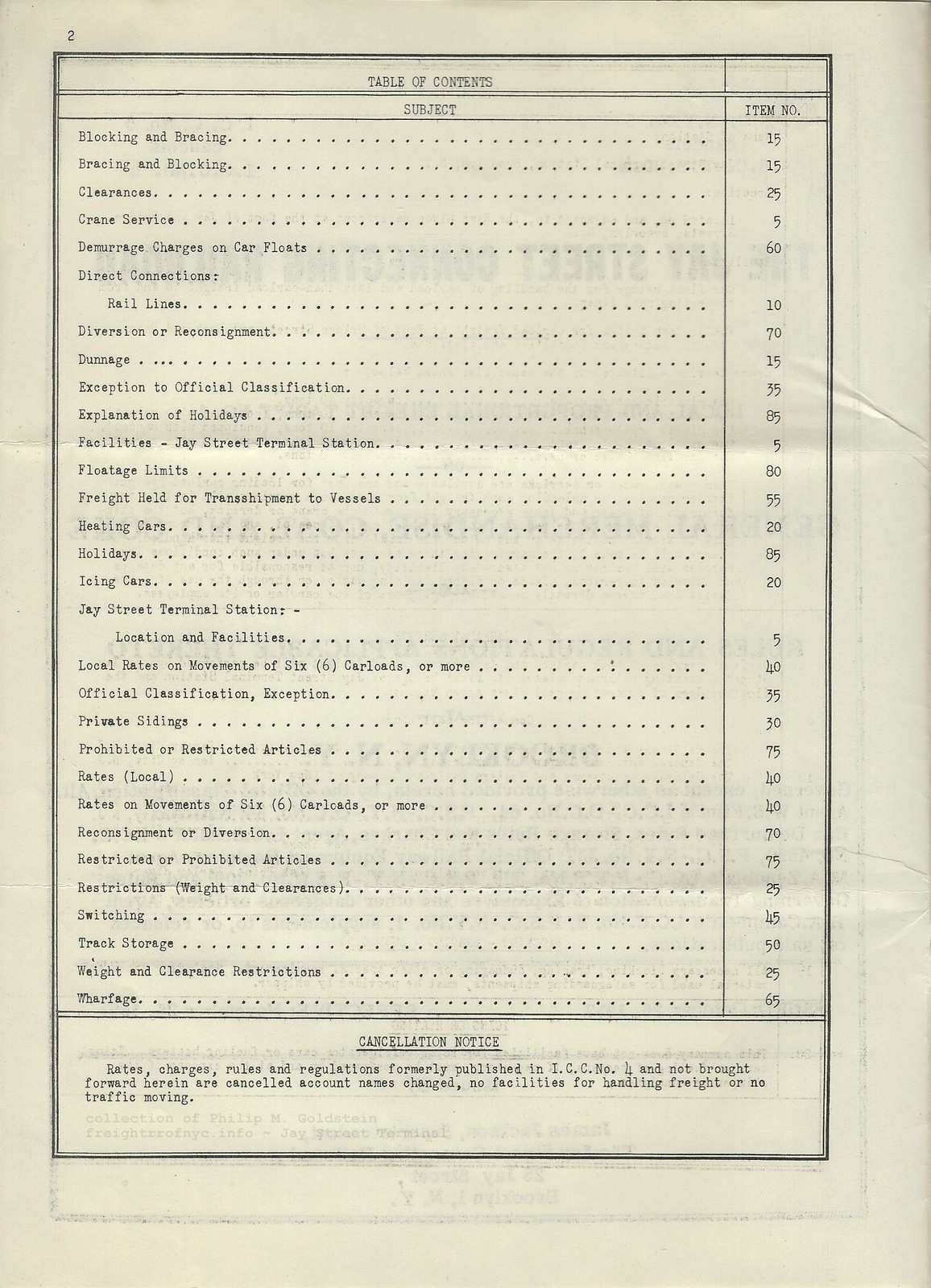 |
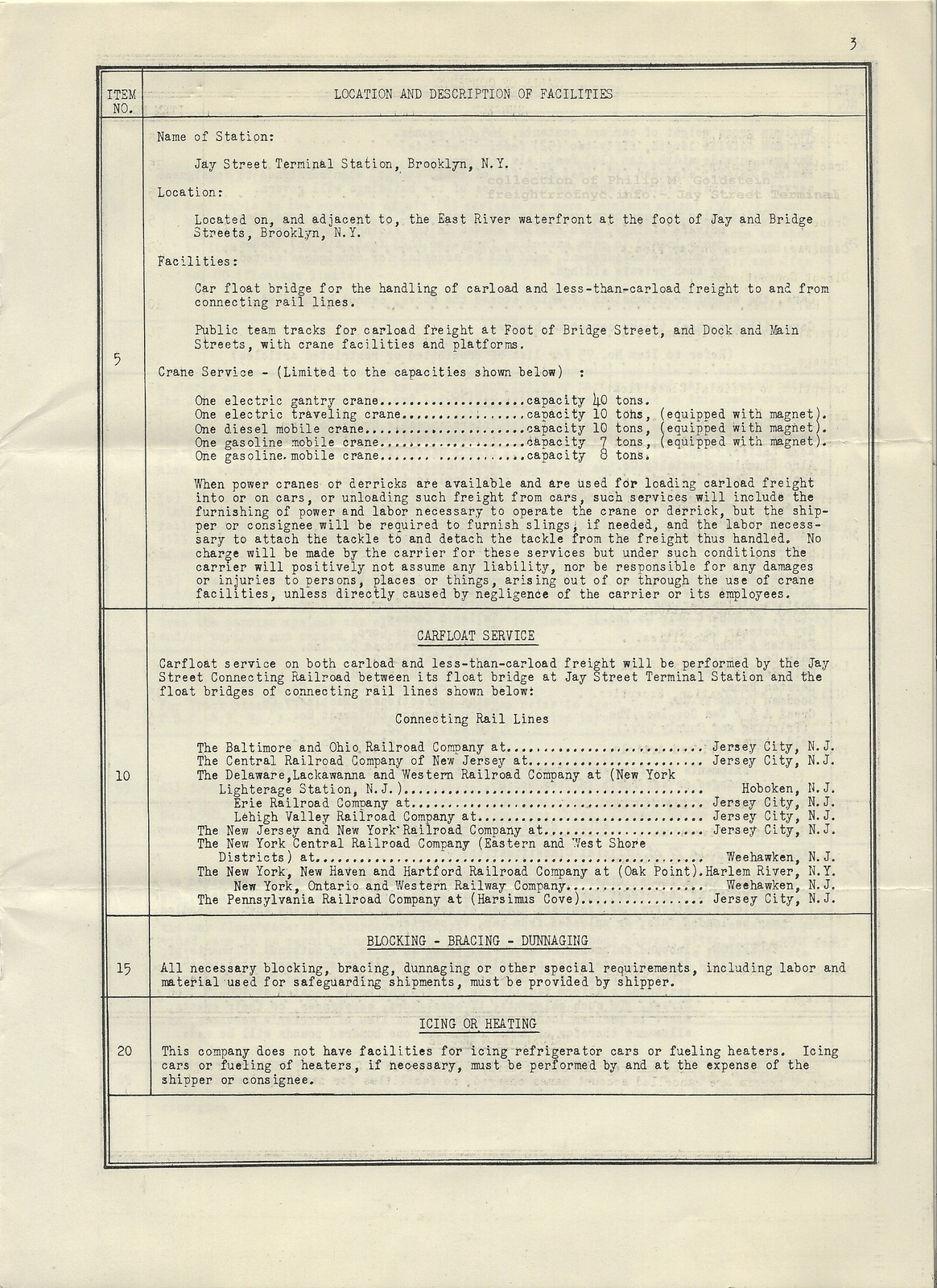 |
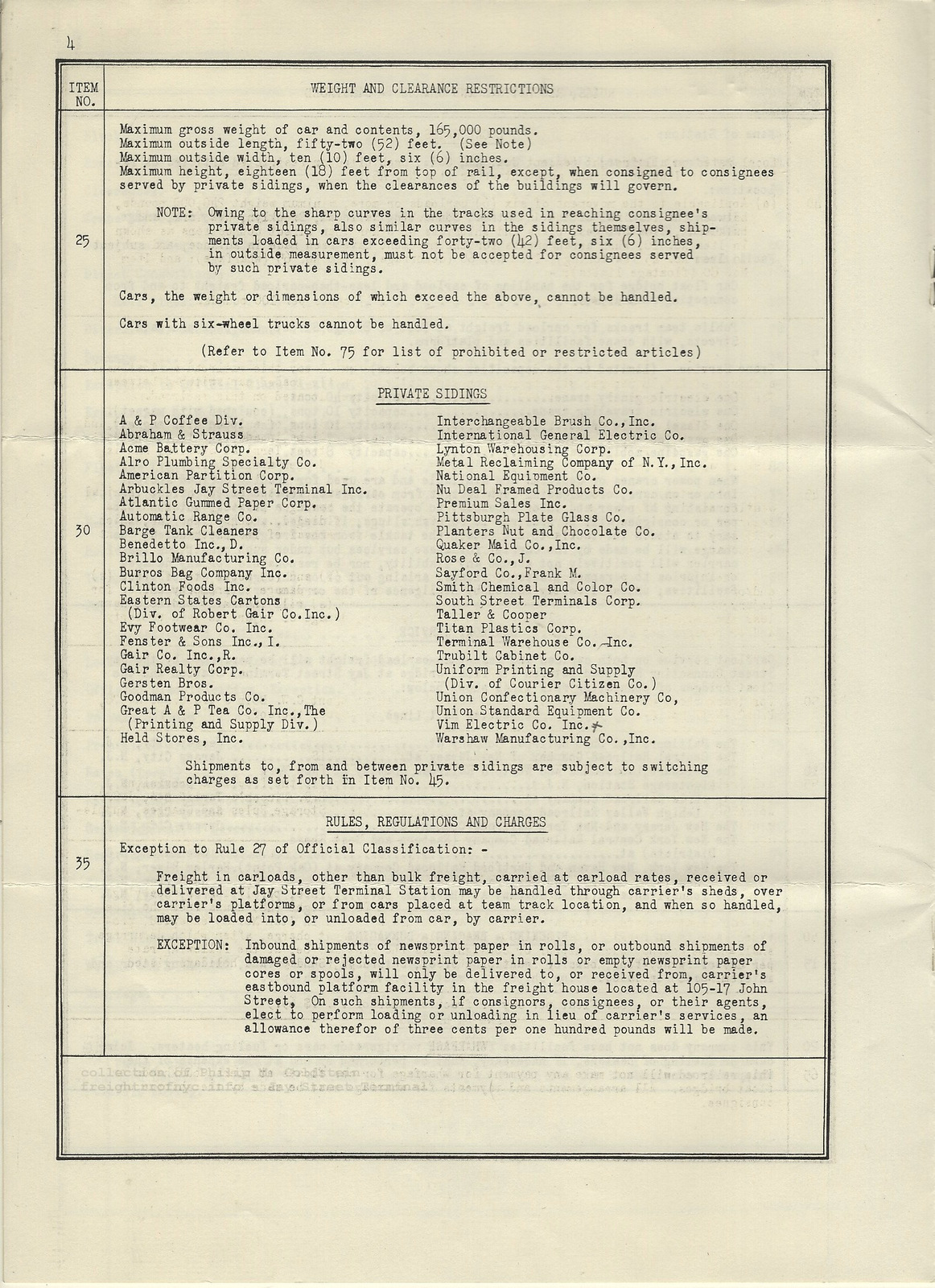 |
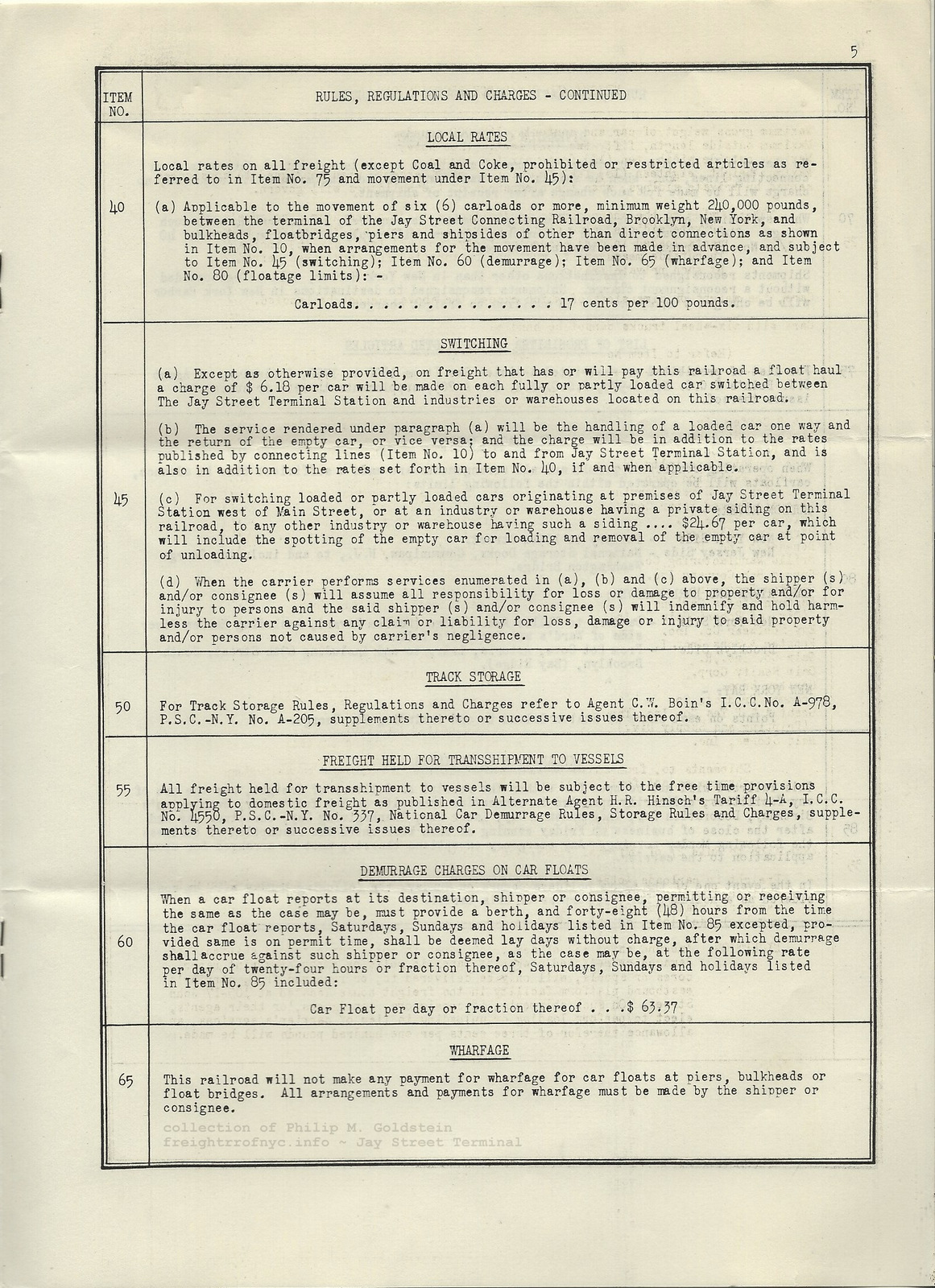 |
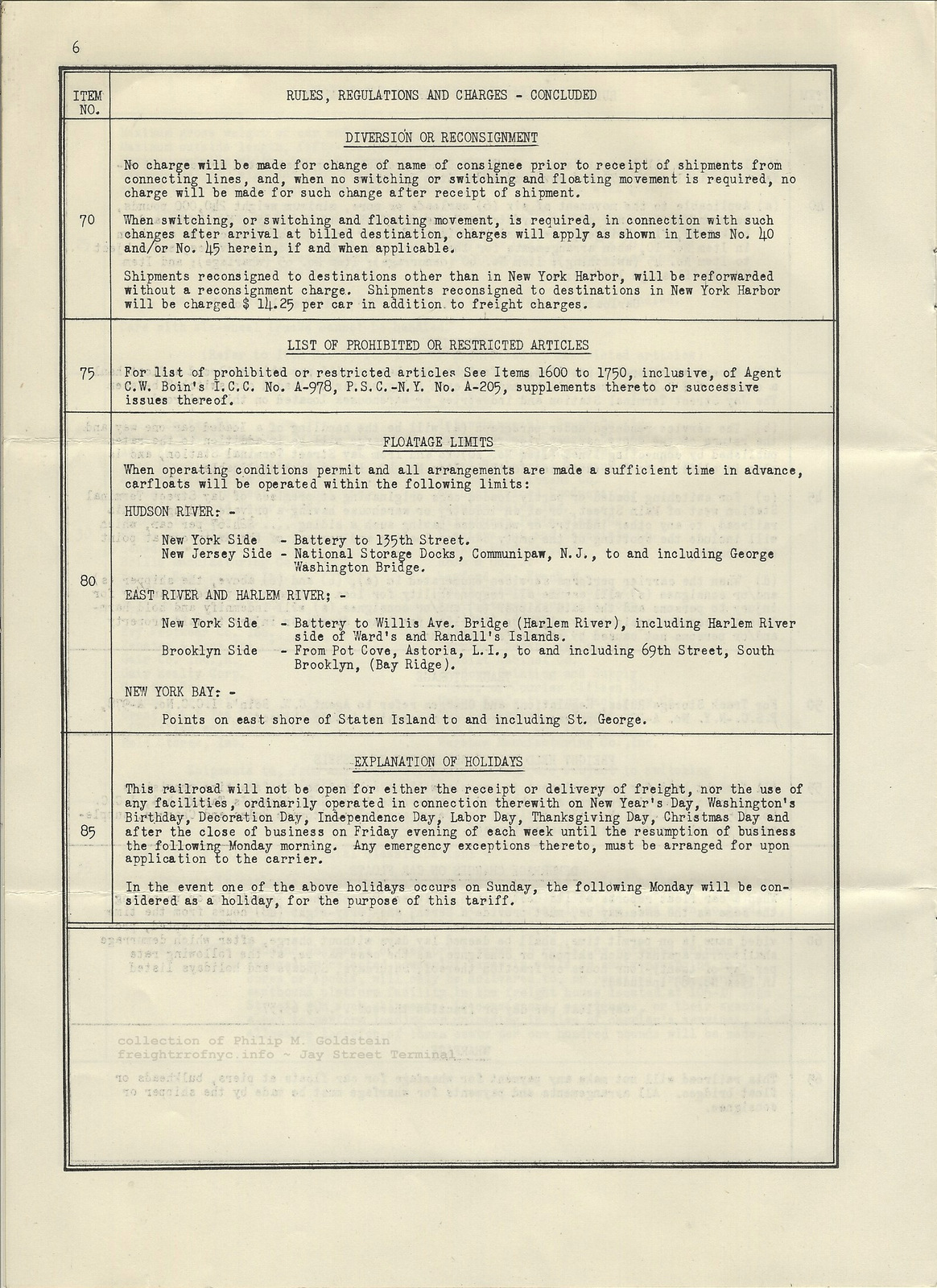 |
| Local & Proportional Freight Tariff - October 26, 1953 General Merchandise, Coal and Coke authors collection added 10 November 2022 |
|
.
.
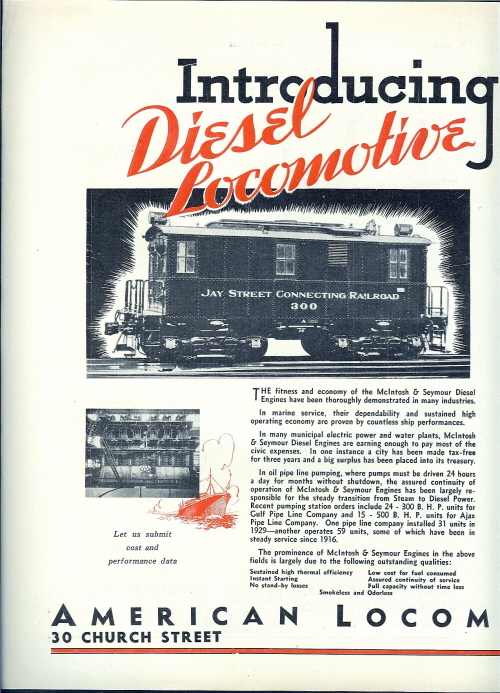 |
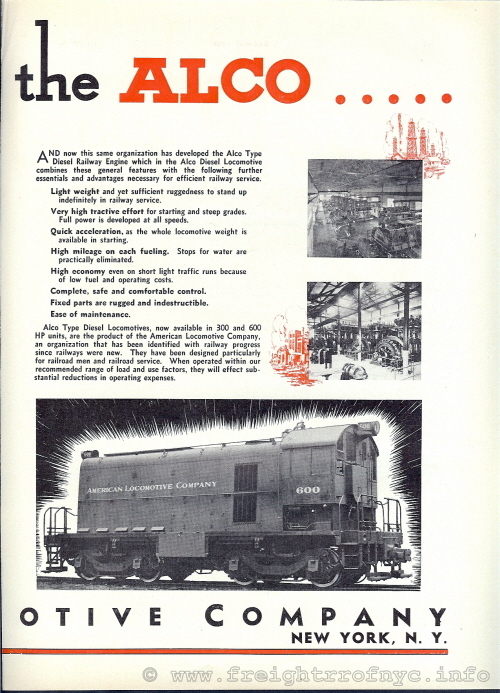 |
|
Railway Age, Vol.. 91, No. 18, two page advertisement
- October 31, 1931 |
|
.
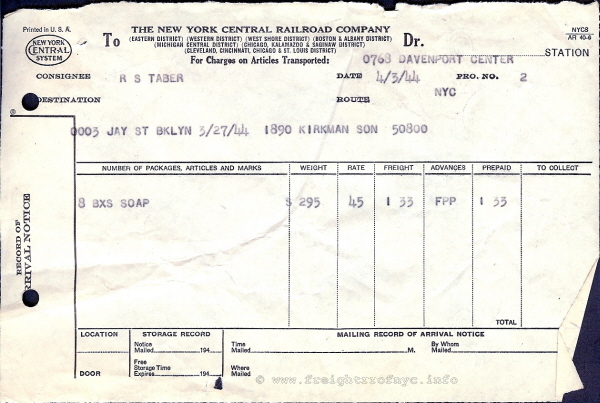
Arrival Notice - 1944
authors
collection
added 22 Jan 2009
.
.
| From "Captain Joe" Lemerise:
Albert Schmidt was my grandfather and night captain of the tug (William A. Jamison). Before being scuttled in the early 1950's (she had no scrap value), the William A. Jamison was the oldest operating tug in the New York City harbor. She had a wooden hull and had a coal fired steam engine. The engine was a two stage (double expansion) reciprocating steam engine. When originally built the tug had no electric power. Lights were either oil or alcohol fired. I have one of the original alcohol burning binnacle lamps: An electric generator was added at a later date. I recall my grandfather proudly showing the generator to me when I was about 8 or 10 years of age. The call sign on her steam whistle was two long blasts, two short blasts and one long blast. I have no idea of the significance of this code. Rudder control was via chains from the wheel in the wheelhouse to the rudder stock. Interestingly and unusual was the fact that to turn the vessel to port you tuned the wheel to starboard and visa versa. The engine order telegraph consisted of a handle and cable mounted of the forward bulkhead in the wheelhouse. Pulling the handle with the appropriate code (number of pulls) would ring a bell in the engine room. I don't know if this information is useful to your web but I thought you'd find it interesting. Capt. Joe |
|
.
.
Like what you see? Suggestions?
Comments?